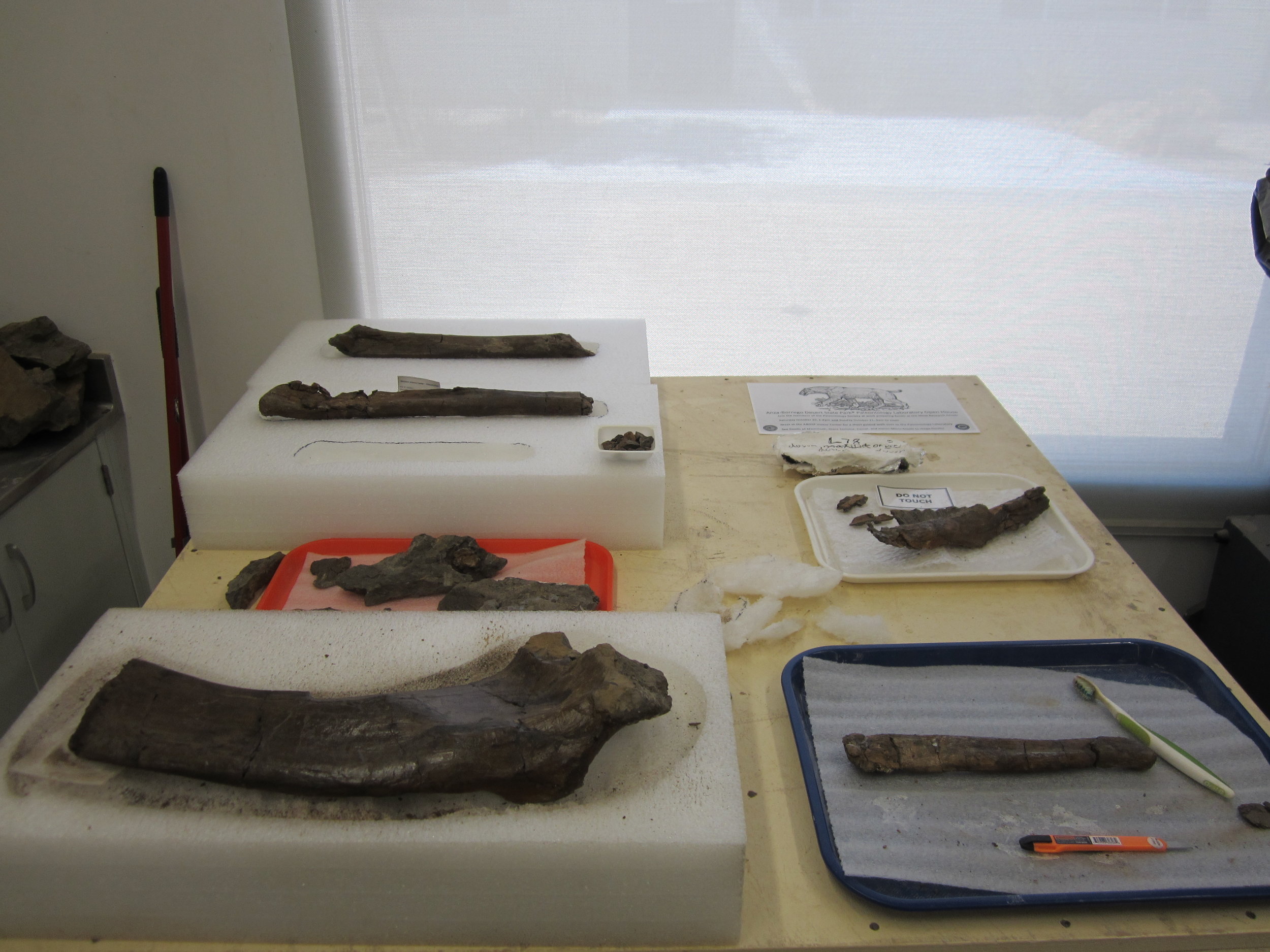 For the last two weeks, I've been giving you updates on the preparation of a big block of rock packed full of hadrosaur bones from New Mexico.All seven bones have now been freed and Western Science Center staff and volunteers are putting the finishing touches on them - removing the last bits of rock, repairing breaks, and reinforcing cracks.
For the last two weeks, I've been giving you updates on the preparation of a big block of rock packed full of hadrosaur bones from New Mexico.All seven bones have now been freed and Western Science Center staff and volunteers are putting the finishing touches on them - removing the last bits of rock, repairing breaks, and reinforcing cracks.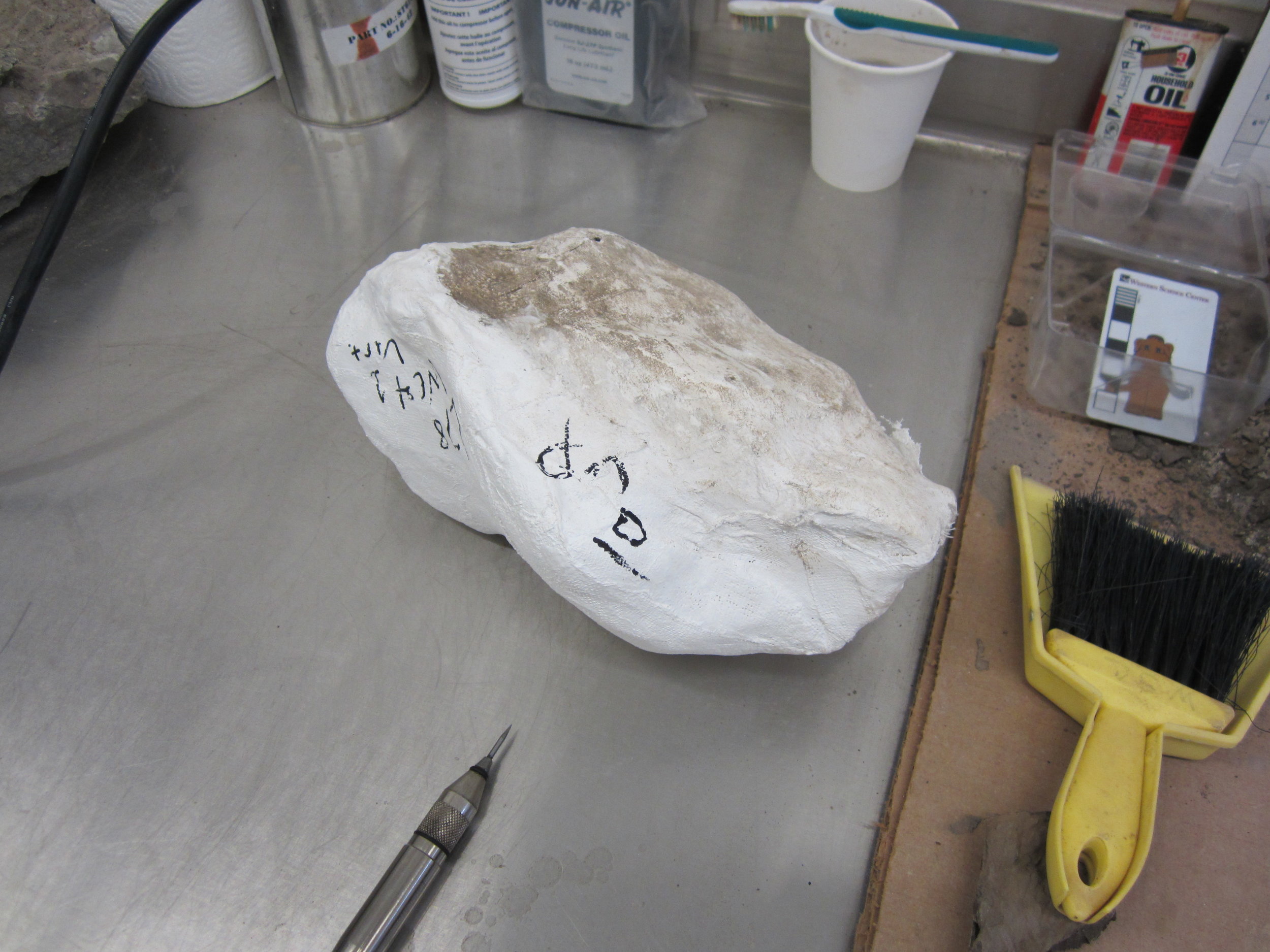 Volunteer Joe Reavis, who worked extremely diligently on the big block for over a month, is now moving on to some smaller jackets from the same quarry, starting with the small jacket pictured here. There are two more jackets twice the size of this one! What parts of this 80-million-year-old herbivorous dinosaur do they contain? I'll continue to post updates as more of this remarkable animal is freed from the mudstone. Post by Curator Dr. Andrew T. McDonald
Volunteer Joe Reavis, who worked extremely diligently on the big block for over a month, is now moving on to some smaller jackets from the same quarry, starting with the small jacket pictured here. There are two more jackets twice the size of this one! What parts of this 80-million-year-old herbivorous dinosaur do they contain? I'll continue to post updates as more of this remarkable animal is freed from the mudstone. Post by Curator Dr. Andrew T. McDonald
Fossil Friday - hadrosaur jacket update
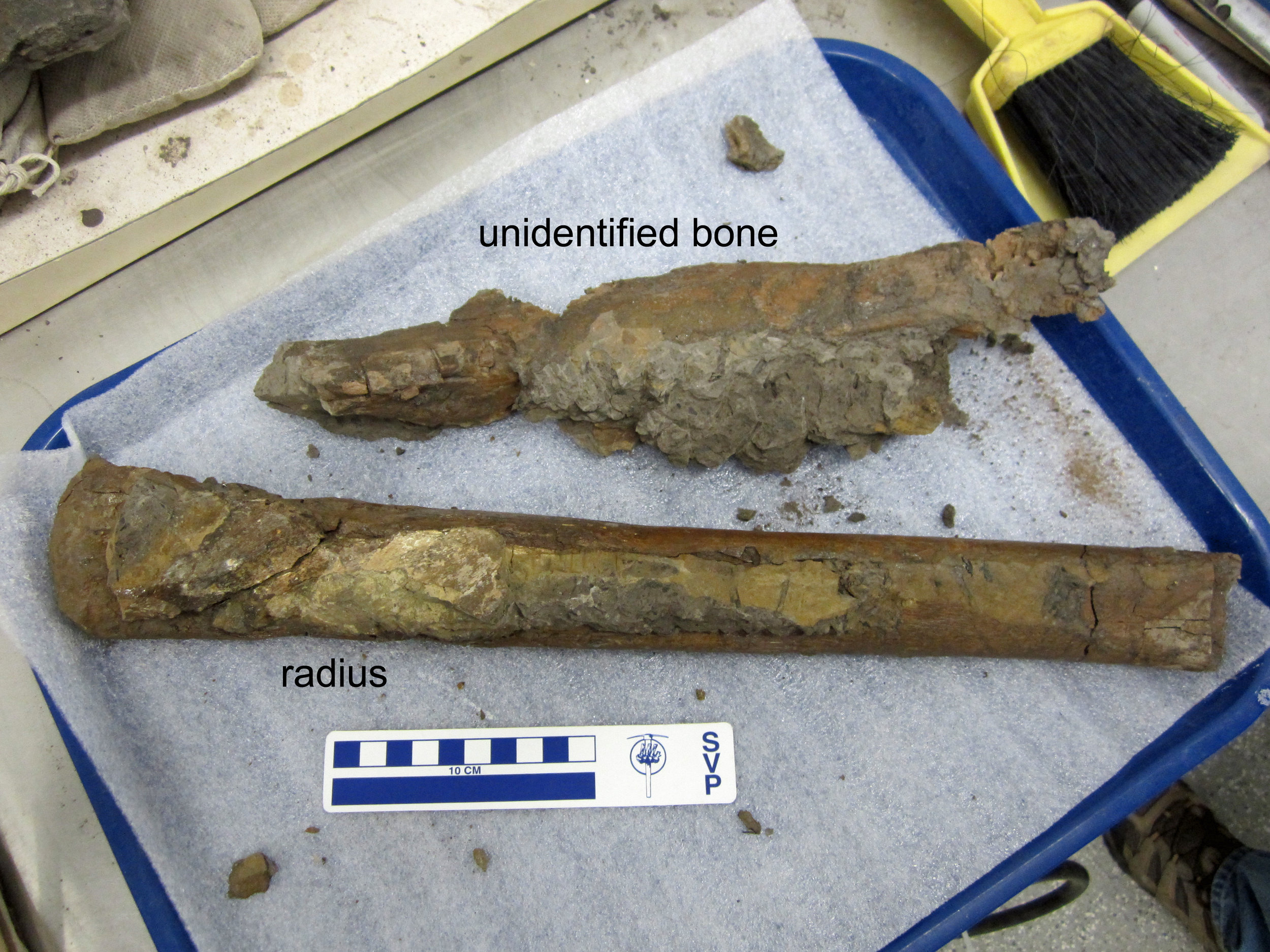 Last week for Fossil Friday, we posted about a big plaster jacket packed full of 80-million-year-old hadrosaur bones, which we brought back to the Western Science Center from New Mexico in June.Volunteer Joe Reavis has been working very diligently on removing the rock from the large but quite fragile bones. Every week brings more progress and greater understanding of which parts of the animal are actually present.Since last Friday, Joe has separated the two forearm bones from the scapula. It was all hands on deck earlier this week as we carefully lifted the two forearm bones away from the jacket, leaving the scapula completely intact. Last week, I identified the two long forearm bones as the left and right radii (https://valleyofthemastodon.wordpress.com/2018/09/21/fossil-friday-hadrosaur-bones/#more-1697). However, one of them is not a radius after all, but is instead an ulna, the other long bone in the forearm.
Last week for Fossil Friday, we posted about a big plaster jacket packed full of 80-million-year-old hadrosaur bones, which we brought back to the Western Science Center from New Mexico in June.Volunteer Joe Reavis has been working very diligently on removing the rock from the large but quite fragile bones. Every week brings more progress and greater understanding of which parts of the animal are actually present.Since last Friday, Joe has separated the two forearm bones from the scapula. It was all hands on deck earlier this week as we carefully lifted the two forearm bones away from the jacket, leaving the scapula completely intact. Last week, I identified the two long forearm bones as the left and right radii (https://valleyofthemastodon.wordpress.com/2018/09/21/fossil-friday-hadrosaur-bones/#more-1697). However, one of them is not a radius after all, but is instead an ulna, the other long bone in the forearm.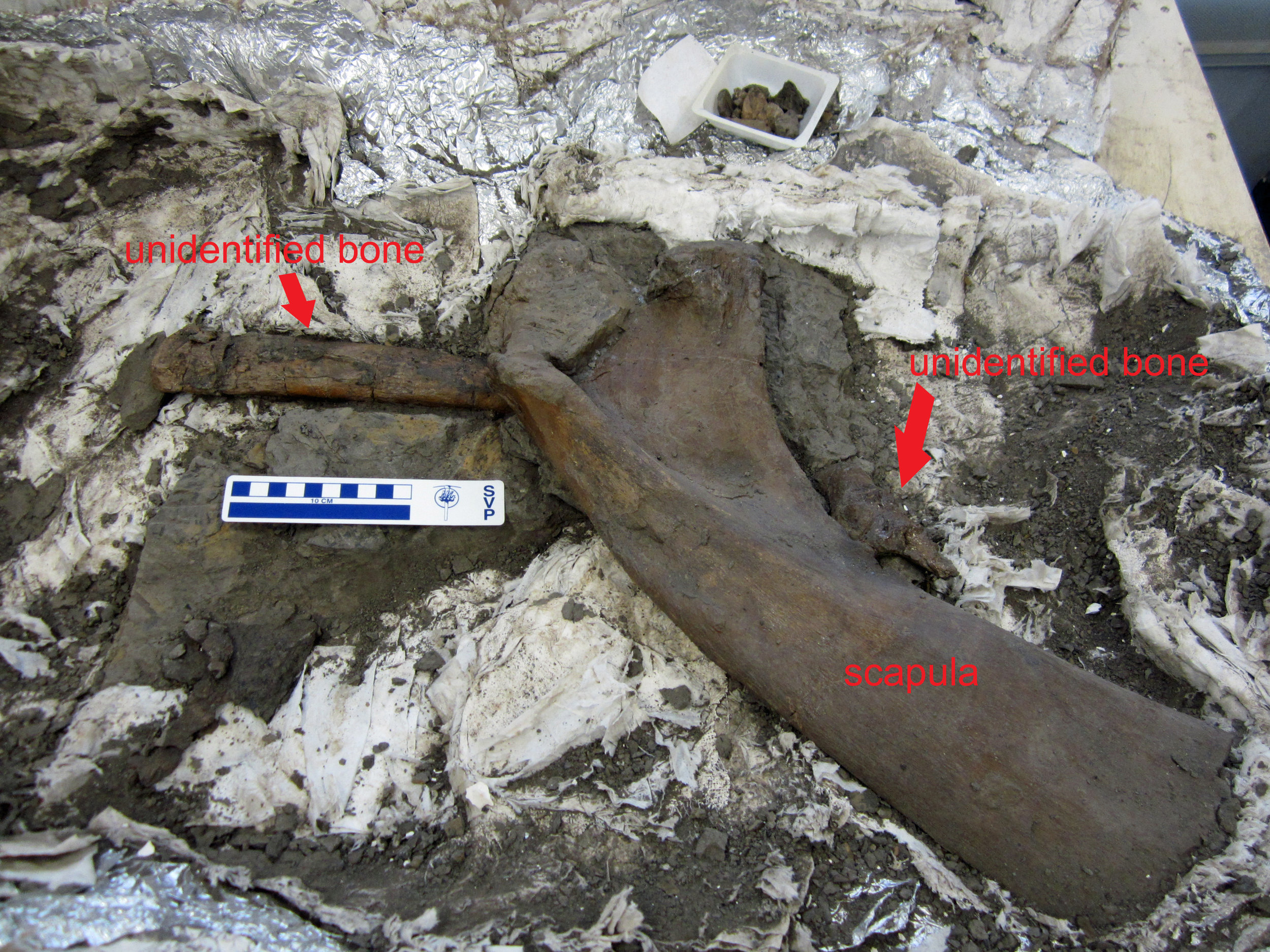 Finding fossils in the field is not the end-all and be-all of discovery. Instead, it's only the first step. As we continue to clean the bones of this hadrosaur skeleton, we will refine the identities of the preserved bones and eventually start to investigate what kind of hadrosaur we have sitting in our lab.
Finding fossils in the field is not the end-all and be-all of discovery. Instead, it's only the first step. As we continue to clean the bones of this hadrosaur skeleton, we will refine the identities of the preserved bones and eventually start to investigate what kind of hadrosaur we have sitting in our lab.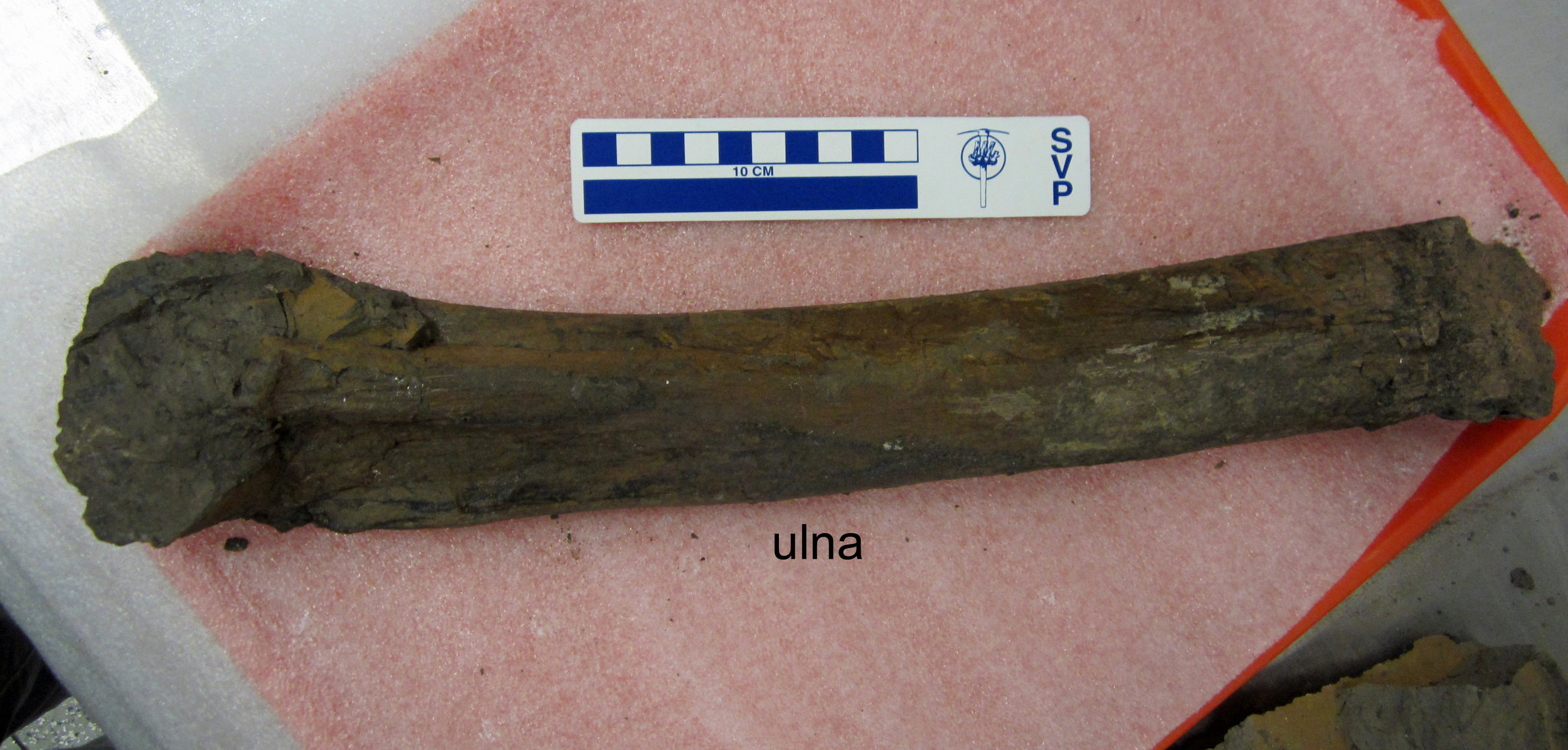 Post by Curator Dr. Andrew McDonald.
Post by Curator Dr. Andrew McDonald.
Fossil Friday - hadrosaur bones
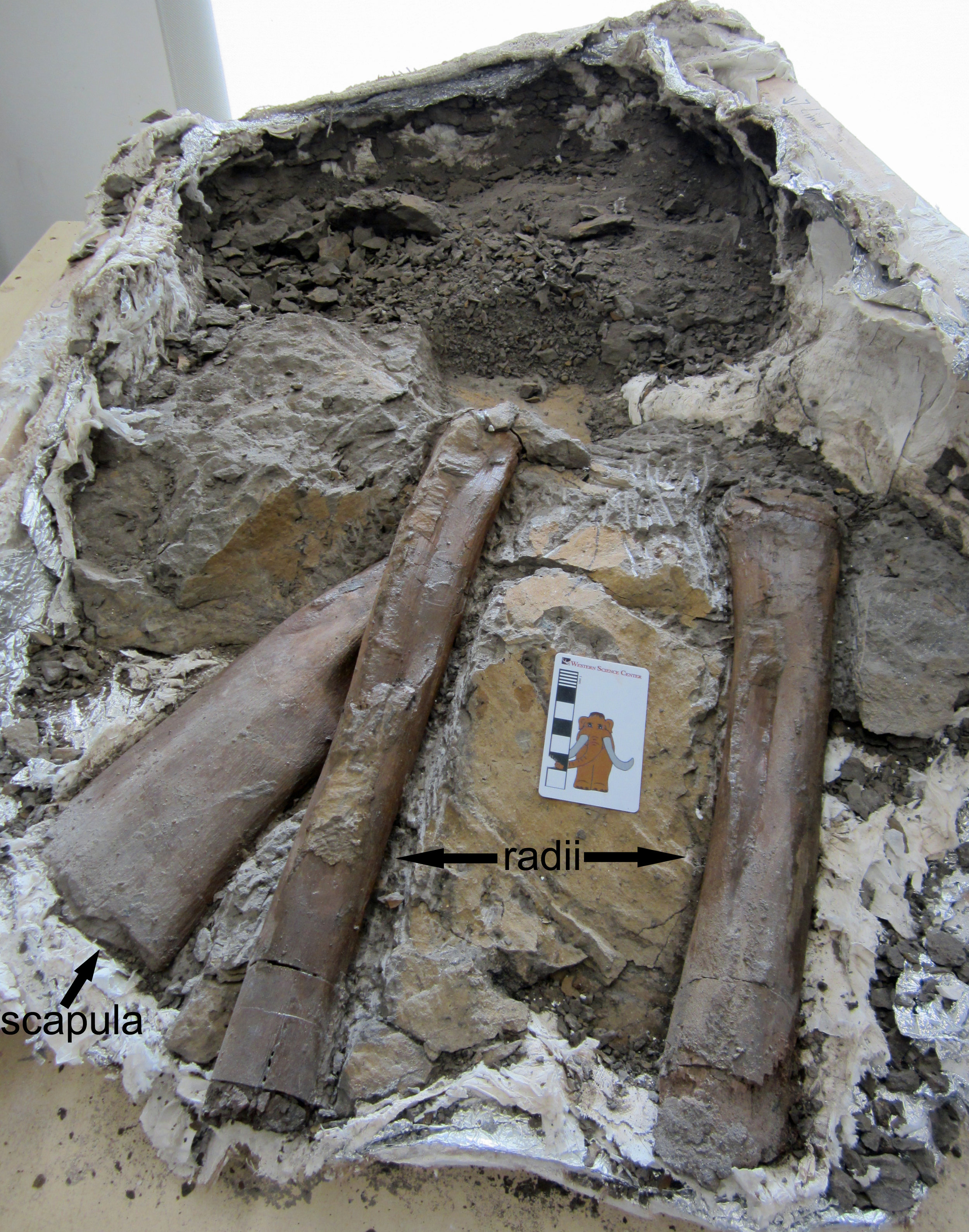 Being wrong is part of the scientific process. Scientists make new discoveries every day, and sometimes prior ideas are supported and sometimes they are refuted as we learn more.Today's Fossil Friday is a perfect example of this, as well as being a really exciting fossil! In June, my colleagues and I returned to the Western Science Center after three weeks of field work in New Mexico. Among the half-ton of 80-million-year-old fossils we brought back was a large plaster jacket containing what I had identified as several bones of a theropod, some sort of medium-sized meat-eating dinosaur.For the last month, Western Science Center volunteer Joe Reavis has been preparing this big block of rock, carefully revealing the bones within. His work has led to a bit of a surprise - the bones are not those of a meat-eating theropod, but instead a plant-eating hadrosaur! Hadrosaurs are often nick-named the "duck-billed" dinosaurs, because of the wide beaks at the front of their mouths. These herbivores could reach 30 feet or more in length and were extremely common in North America during the last 20 million years of the age of dinosaurs, right up to the mass extinction 66 million years ago that wiped out all the dinosaurs except modern birds.Isolated hadrosaur bones are abundant in the Menefee Formation, the layer of rock we are studying in New Mexico. However, this large jacket contains at least three limb bones in close proximity. So far, Joe has uncovered the right scapula (shoulder blade) and both radii (the radius is a long bone in the forearm). This next image shows the arms of AMNH 5886, a skeleton of the later hadrosaur Edmontosaurus annectens, which I photographed at the American Museum of Natural History in New York. The right scapula and both the left radius and right radius are labelled.
Being wrong is part of the scientific process. Scientists make new discoveries every day, and sometimes prior ideas are supported and sometimes they are refuted as we learn more.Today's Fossil Friday is a perfect example of this, as well as being a really exciting fossil! In June, my colleagues and I returned to the Western Science Center after three weeks of field work in New Mexico. Among the half-ton of 80-million-year-old fossils we brought back was a large plaster jacket containing what I had identified as several bones of a theropod, some sort of medium-sized meat-eating dinosaur.For the last month, Western Science Center volunteer Joe Reavis has been preparing this big block of rock, carefully revealing the bones within. His work has led to a bit of a surprise - the bones are not those of a meat-eating theropod, but instead a plant-eating hadrosaur! Hadrosaurs are often nick-named the "duck-billed" dinosaurs, because of the wide beaks at the front of their mouths. These herbivores could reach 30 feet or more in length and were extremely common in North America during the last 20 million years of the age of dinosaurs, right up to the mass extinction 66 million years ago that wiped out all the dinosaurs except modern birds.Isolated hadrosaur bones are abundant in the Menefee Formation, the layer of rock we are studying in New Mexico. However, this large jacket contains at least three limb bones in close proximity. So far, Joe has uncovered the right scapula (shoulder blade) and both radii (the radius is a long bone in the forearm). This next image shows the arms of AMNH 5886, a skeleton of the later hadrosaur Edmontosaurus annectens, which I photographed at the American Museum of Natural History in New York. The right scapula and both the left radius and right radius are labelled.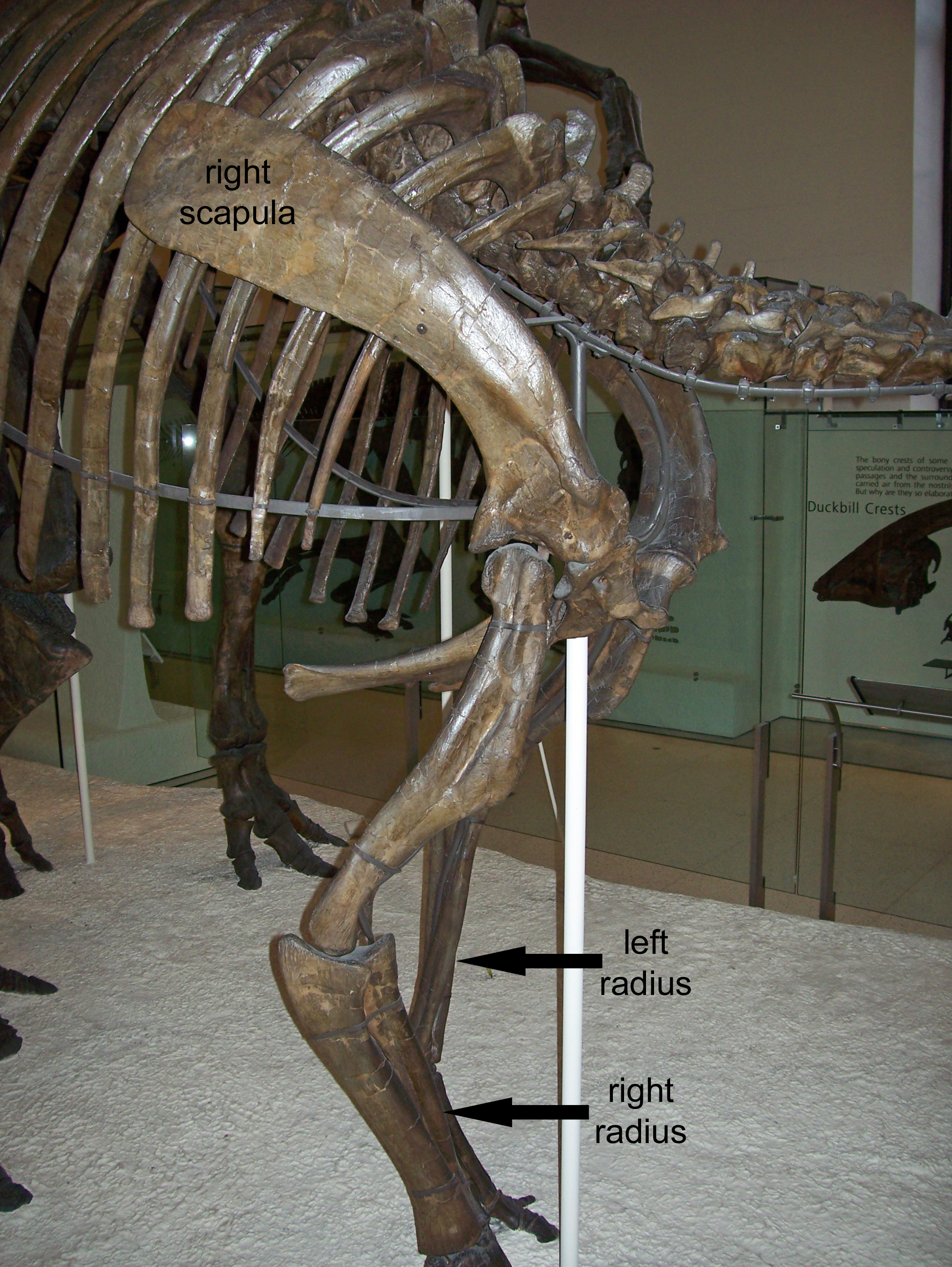 There is still more rock to be removed in the big jacket, and we brought back half a dozen smaller jackets containing other bones from the same site, one of which contains a hadrosaur vertebra. So, we will have much more to say about this remarkable animal in the future. The fossils were collected by staff and volunteers from the Western Science Center, Zuni Dinosaur Institute for Geosciences, and Southwest Paleontological Society.Post by Curator Dr. Andrew T. McDonald
There is still more rock to be removed in the big jacket, and we brought back half a dozen smaller jackets containing other bones from the same site, one of which contains a hadrosaur vertebra. So, we will have much more to say about this remarkable animal in the future. The fossils were collected by staff and volunteers from the Western Science Center, Zuni Dinosaur Institute for Geosciences, and Southwest Paleontological Society.Post by Curator Dr. Andrew T. McDonald
Fossil Friday - camel tooth
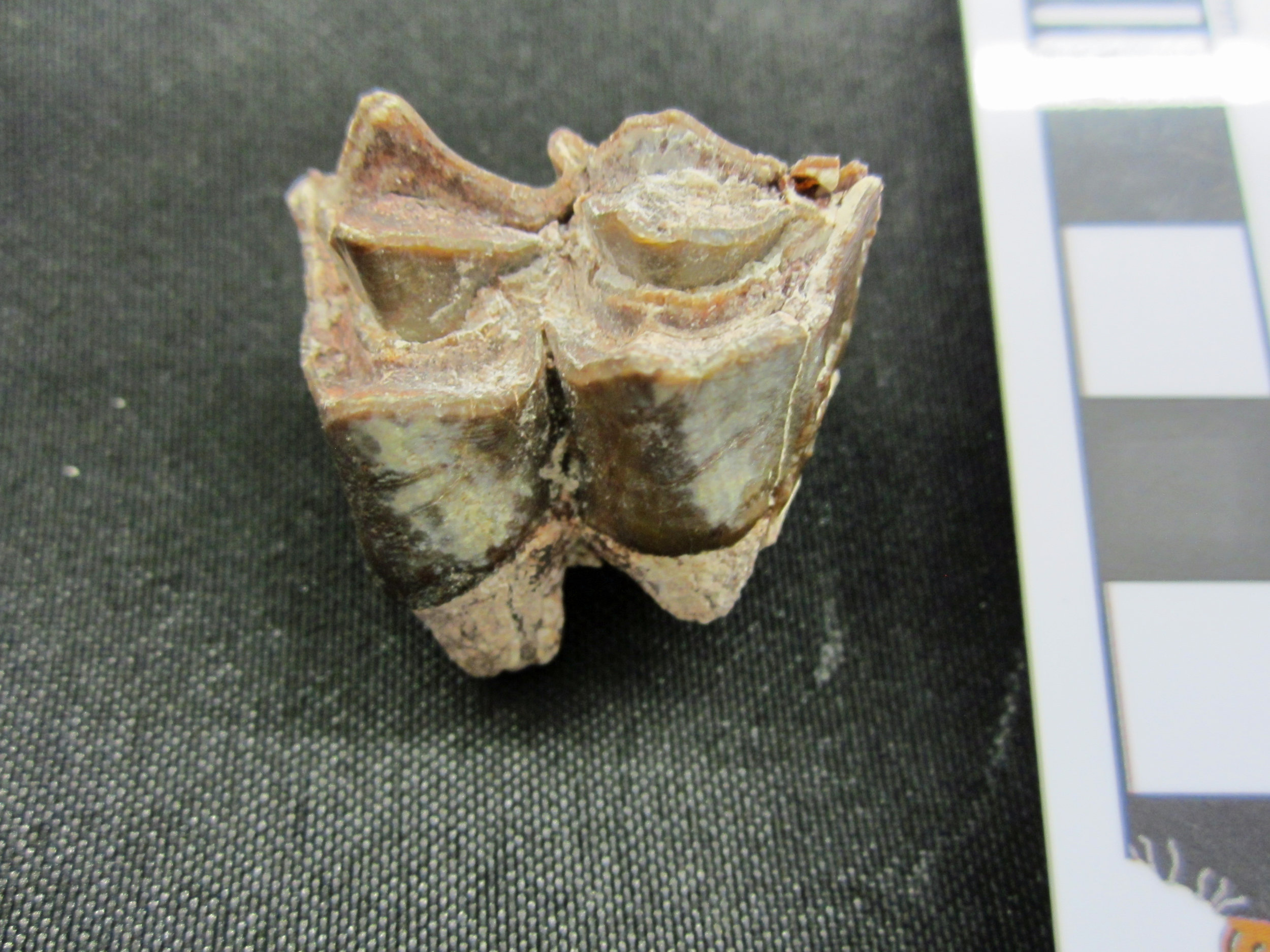 Every day on my way to work, I drive past a farm that among its denizens counts several camels. Apart from the fun of seeing these large, strange mammals, they also serve as a reminder that wild camels once roamed across North America, until their extinction around 12,000 years ago. Although today, wild camels and their relatives are found in Asia, Africa, and South America, in a bit of evolutionary irony, camels actually originated in North America and spread around the world from there. The first camels appeared around 35 million years ago during the Eocene Epoch, in the form of small fast-running herbivores like Poebrotherium. By the Miocene Epoch, camels had diversified and grown larger. This image shows one of the upper left cheek teeth of a camel that lived here in California between 18 and 14 million years ago. This tooth was collected by the Western Science Center earlier this year at a fossil site in San Bernardino National Forest. It might belong to an extinct camel called Aepycamelus, which was widespread in North America during the Miocene. However, we are still studying this tooth to determine exactly what species it represents.
Every day on my way to work, I drive past a farm that among its denizens counts several camels. Apart from the fun of seeing these large, strange mammals, they also serve as a reminder that wild camels once roamed across North America, until their extinction around 12,000 years ago. Although today, wild camels and their relatives are found in Asia, Africa, and South America, in a bit of evolutionary irony, camels actually originated in North America and spread around the world from there. The first camels appeared around 35 million years ago during the Eocene Epoch, in the form of small fast-running herbivores like Poebrotherium. By the Miocene Epoch, camels had diversified and grown larger. This image shows one of the upper left cheek teeth of a camel that lived here in California between 18 and 14 million years ago. This tooth was collected by the Western Science Center earlier this year at a fossil site in San Bernardino National Forest. It might belong to an extinct camel called Aepycamelus, which was widespread in North America during the Miocene. However, we are still studying this tooth to determine exactly what species it represents.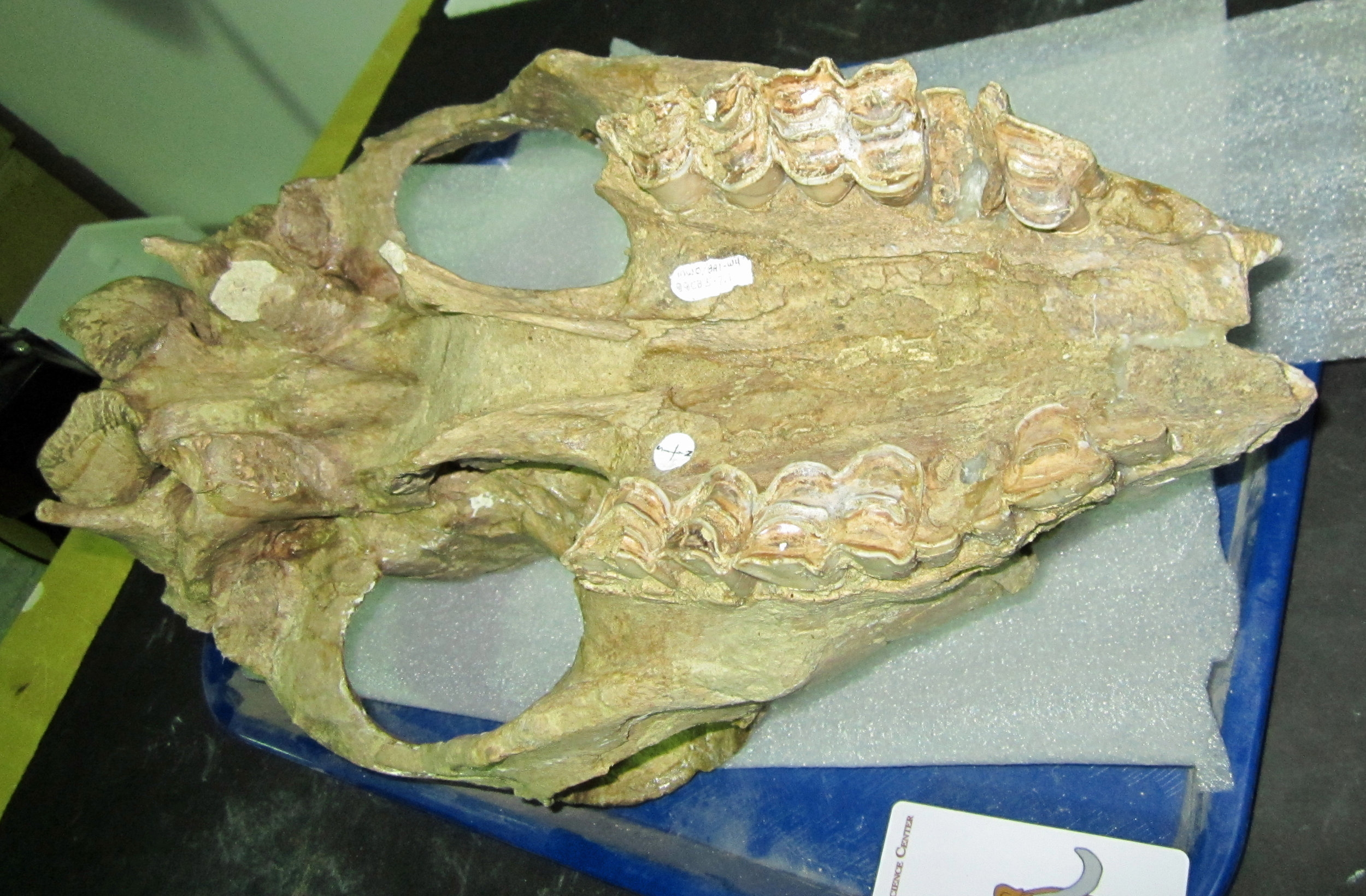 Camels kept going strong in North America up until their extinction at the end of the last Ice Age. One of the last camels in North America was the large species Camelops hesternus, which ranged across western Northern America, including California. This image shows the underside of a Camelops skull discovered at Diamond Valley Lake and which is part of the Western Science Center's collection. The teeth are highly worn, but still bear a close resemblance to the smaller Miocene tooth. Post by WSC Curator Dr. Andrew T. McDonald
Camels kept going strong in North America up until their extinction at the end of the last Ice Age. One of the last camels in North America was the large species Camelops hesternus, which ranged across western Northern America, including California. This image shows the underside of a Camelops skull discovered at Diamond Valley Lake and which is part of the Western Science Center's collection. The teeth are highly worn, but still bear a close resemblance to the smaller Miocene tooth. Post by WSC Curator Dr. Andrew T. McDonald
Fossil Friday - mastodon skull update
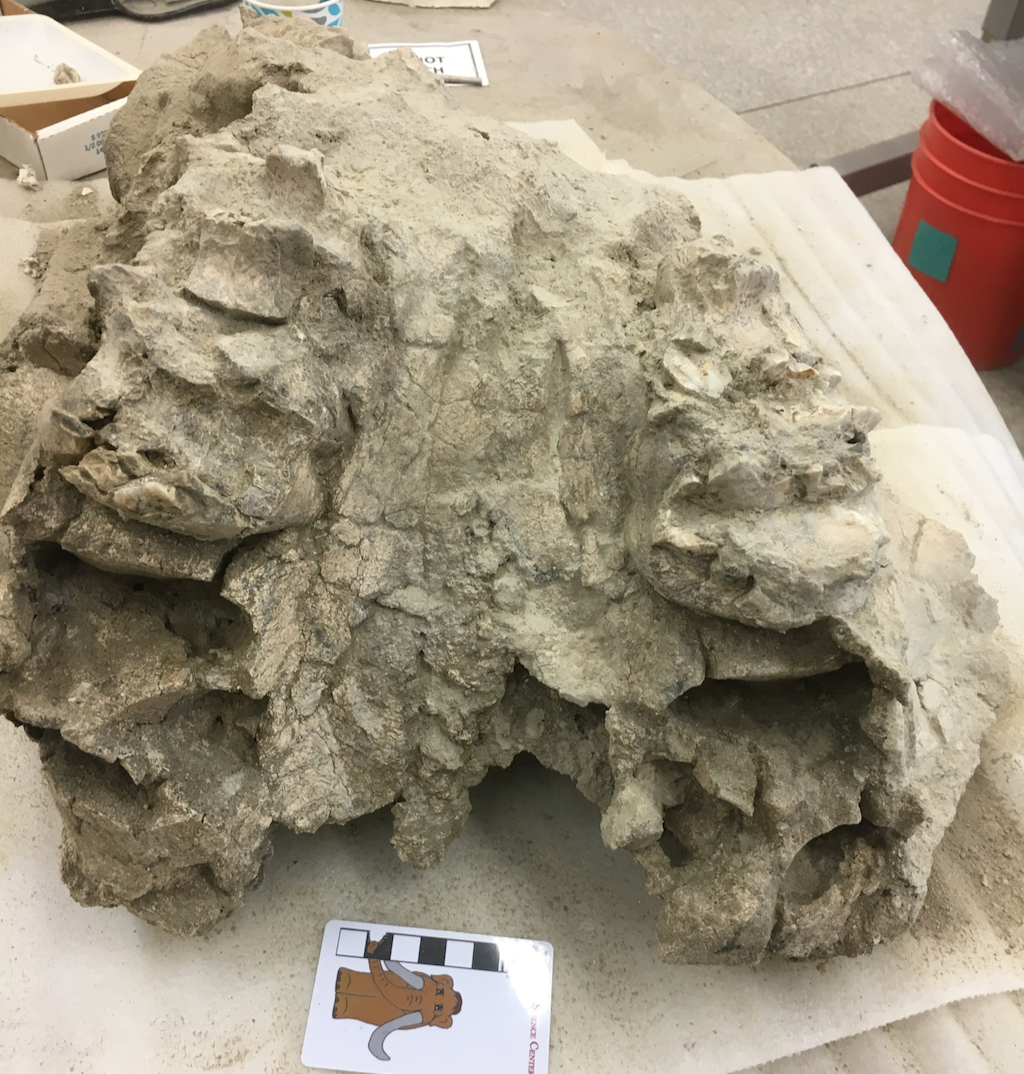 A few weeks ago I wrote about a mastodon skull we had moved into the lab for additional prep work. Kind of a lot has happened since then.We managed to successfully remove the remaining part of the original field jacket, which had bee on the skull since it was first found in 1997. That enabled us to turn the skull over and start working on the ventral side, where we could get a better view of the teeth.I speculated last week that this skull was almost certainly either a juvenile or a female, based on its small size and small tusk diameter (while the tusks aren't preserved, their sockets are). The determination between juvenile and female depended on whether or not the preserved tooth was the 1st molar (indicating a young animal) or the 2nd molar (indicating a young adult, and therefore probably a female). It turns out everyone was wrong!
A few weeks ago I wrote about a mastodon skull we had moved into the lab for additional prep work. Kind of a lot has happened since then.We managed to successfully remove the remaining part of the original field jacket, which had bee on the skull since it was first found in 1997. That enabled us to turn the skull over and start working on the ventral side, where we could get a better view of the teeth.I speculated last week that this skull was almost certainly either a juvenile or a female, based on its small size and small tusk diameter (while the tusks aren't preserved, their sockets are). The determination between juvenile and female depended on whether or not the preserved tooth was the 1st molar (indicating a young animal) or the 2nd molar (indicating a young adult, and therefore probably a female). It turns out everyone was wrong!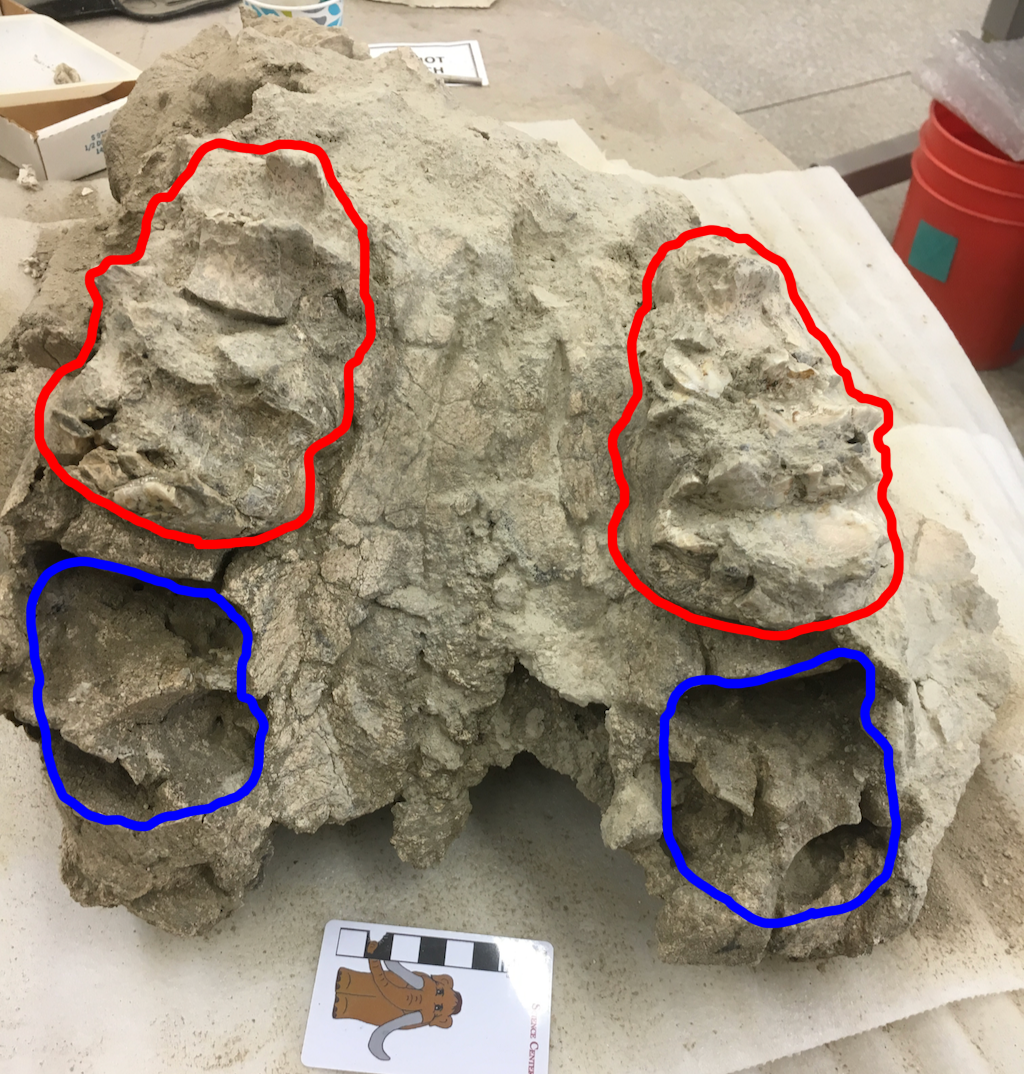 The teeth are outlined in blue above, with the empty tooth sockets outlined in blue. The teeth turned out to be 3rd molars, making the animal much older than I thought! The empty sockets, instead of being for the 4th premolars or 1st molars, were actually for the 2nd molars.The 3rd molars in this case were either unerupted or just starting to erupt; the 2nd molars probably fell out after death. That means this mastodon was probably between 25 and 30 years old when it died. Instead of the pre-teen or teenager I expected, this was a fully mature female mastodon, the first one identified from Diamond Valley Lake.We still have a bit more cleaning to do to the skull. Unfortunately, while there is a substantial amount of bone present behind the palate, it is completely splintered and probably can't be reconstructed. Even so, we'll be getting some good data from this specimen.
The teeth are outlined in blue above, with the empty tooth sockets outlined in blue. The teeth turned out to be 3rd molars, making the animal much older than I thought! The empty sockets, instead of being for the 4th premolars or 1st molars, were actually for the 2nd molars.The 3rd molars in this case were either unerupted or just starting to erupt; the 2nd molars probably fell out after death. That means this mastodon was probably between 25 and 30 years old when it died. Instead of the pre-teen or teenager I expected, this was a fully mature female mastodon, the first one identified from Diamond Valley Lake.We still have a bit more cleaning to do to the skull. Unfortunately, while there is a substantial amount of bone present behind the palate, it is completely splintered and probably can't be reconstructed. Even so, we'll be getting some good data from this specimen.
Fossil Friday - Invictarx zephyri
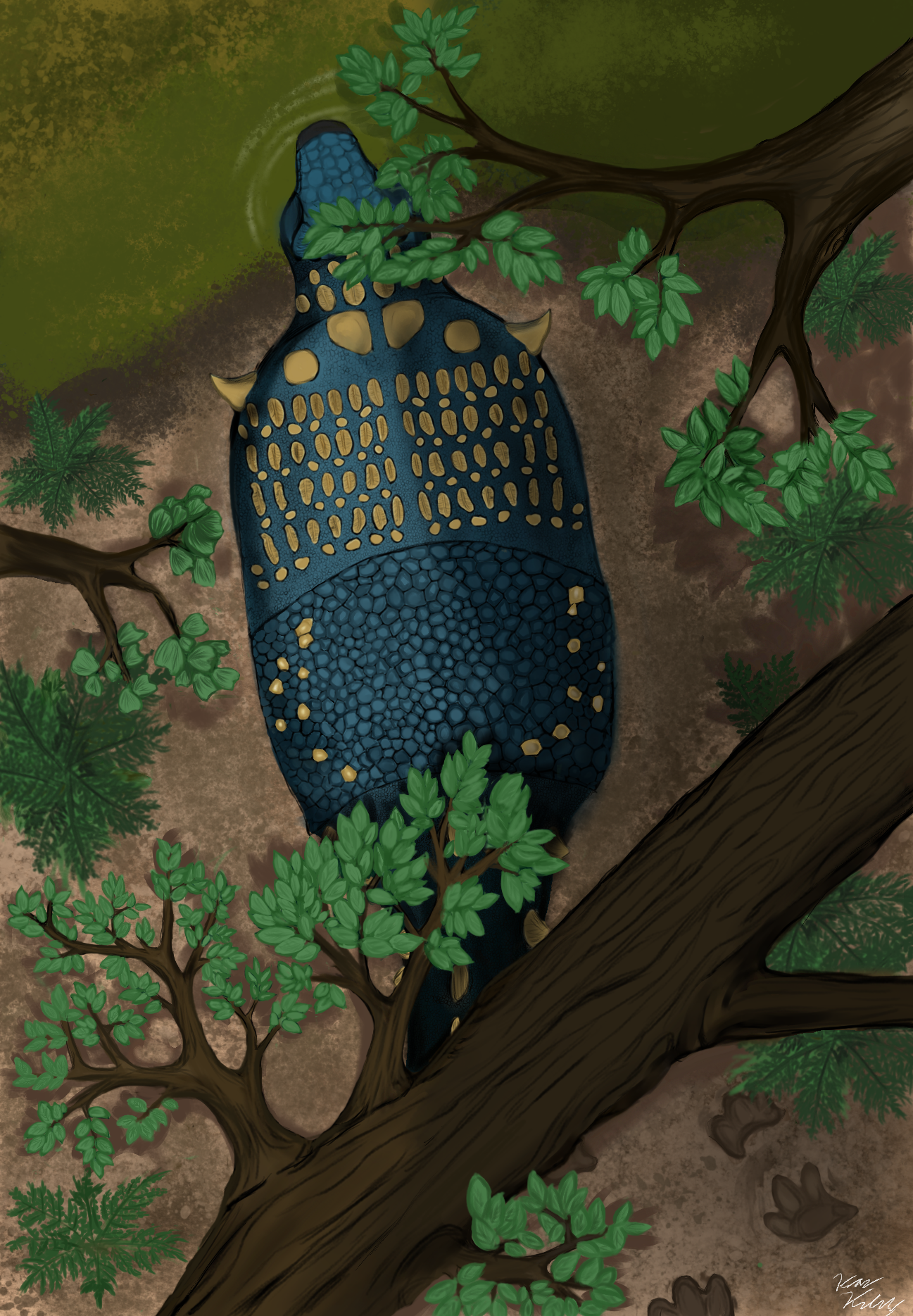 Welcome Invictarx zephyri! This is a very special Fossil Friday for me and everyone here at Western Science Center, and our colleagues at Zuni Dinosaur Institute for Geosciences and Southwest Paleontological Society. The paper naming and describing this new armored plant-eating dinosaur was published today in the online, open-access journal PeerJ. These are the fossils of Invictarx laid out, including vertebrae, parts of the forelimbs, and many osteoderms, the bony armor plates that would have been set in the animal's scaly hide - picture the armored back of an alligator. The image is a composite of three different fossil skeletons found at different spots but in the same rock layer in northwestern New Mexico, and all belonging to Invictarx zephyri.
Welcome Invictarx zephyri! This is a very special Fossil Friday for me and everyone here at Western Science Center, and our colleagues at Zuni Dinosaur Institute for Geosciences and Southwest Paleontological Society. The paper naming and describing this new armored plant-eating dinosaur was published today in the online, open-access journal PeerJ. These are the fossils of Invictarx laid out, including vertebrae, parts of the forelimbs, and many osteoderms, the bony armor plates that would have been set in the animal's scaly hide - picture the armored back of an alligator. The image is a composite of three different fossil skeletons found at different spots but in the same rock layer in northwestern New Mexico, and all belonging to Invictarx zephyri.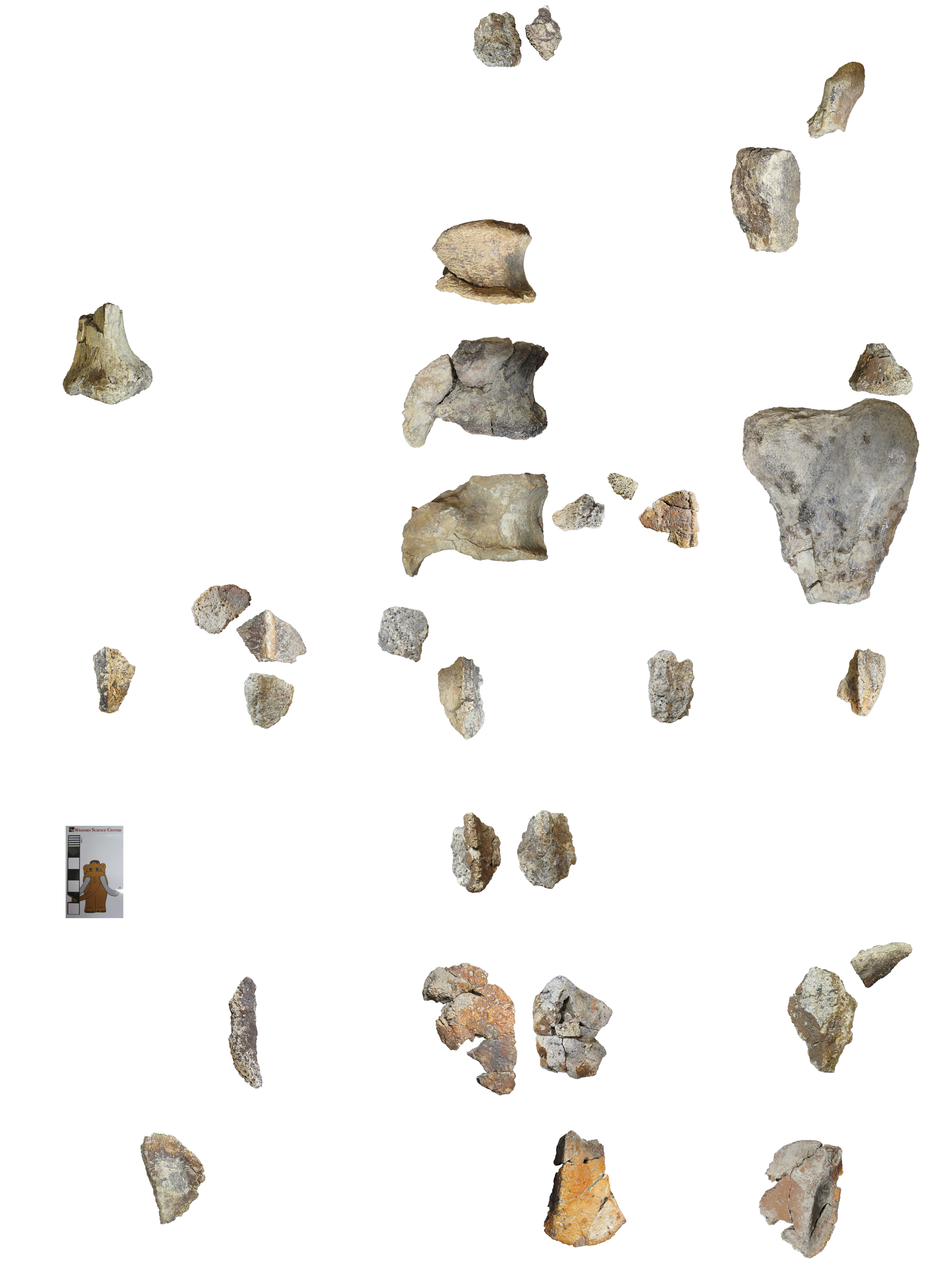 Invictarx lived 80 million years ago, when New Mexico was covered in lush forests, dank swamps, and sluggish rivers, a far cry from the parched badlands in which my colleagues and I found the fossil remains. Invictarx is a nodosaurid, a group of armored dinosaurs that includes many species from North America and Europe. The osteoderms of Invictarx have a unique set of features that set them apart from all other nodosaurids, indicating that we have a new species on our hands, one never found by paleontologists before. Like other nodosaurids, Invictarx sported armor plates across its neck, back, and hips, which probably provided a formidable defense against predators like tyrannosaurs. We collected the first skeleton of Invictarx in 2011, at a site perched atop a high ridge whipped by 40 mile-per-hour winds, which made for a challenging excavation. With all this in mind, my sister and I took out our Latin dictionaries and came up with the name Invictarx zephyri, the "unconquerable fortress of the western wind".
Invictarx lived 80 million years ago, when New Mexico was covered in lush forests, dank swamps, and sluggish rivers, a far cry from the parched badlands in which my colleagues and I found the fossil remains. Invictarx is a nodosaurid, a group of armored dinosaurs that includes many species from North America and Europe. The osteoderms of Invictarx have a unique set of features that set them apart from all other nodosaurids, indicating that we have a new species on our hands, one never found by paleontologists before. Like other nodosaurids, Invictarx sported armor plates across its neck, back, and hips, which probably provided a formidable defense against predators like tyrannosaurs. We collected the first skeleton of Invictarx in 2011, at a site perched atop a high ridge whipped by 40 mile-per-hour winds, which made for a challenging excavation. With all this in mind, my sister and I took out our Latin dictionaries and came up with the name Invictarx zephyri, the "unconquerable fortress of the western wind".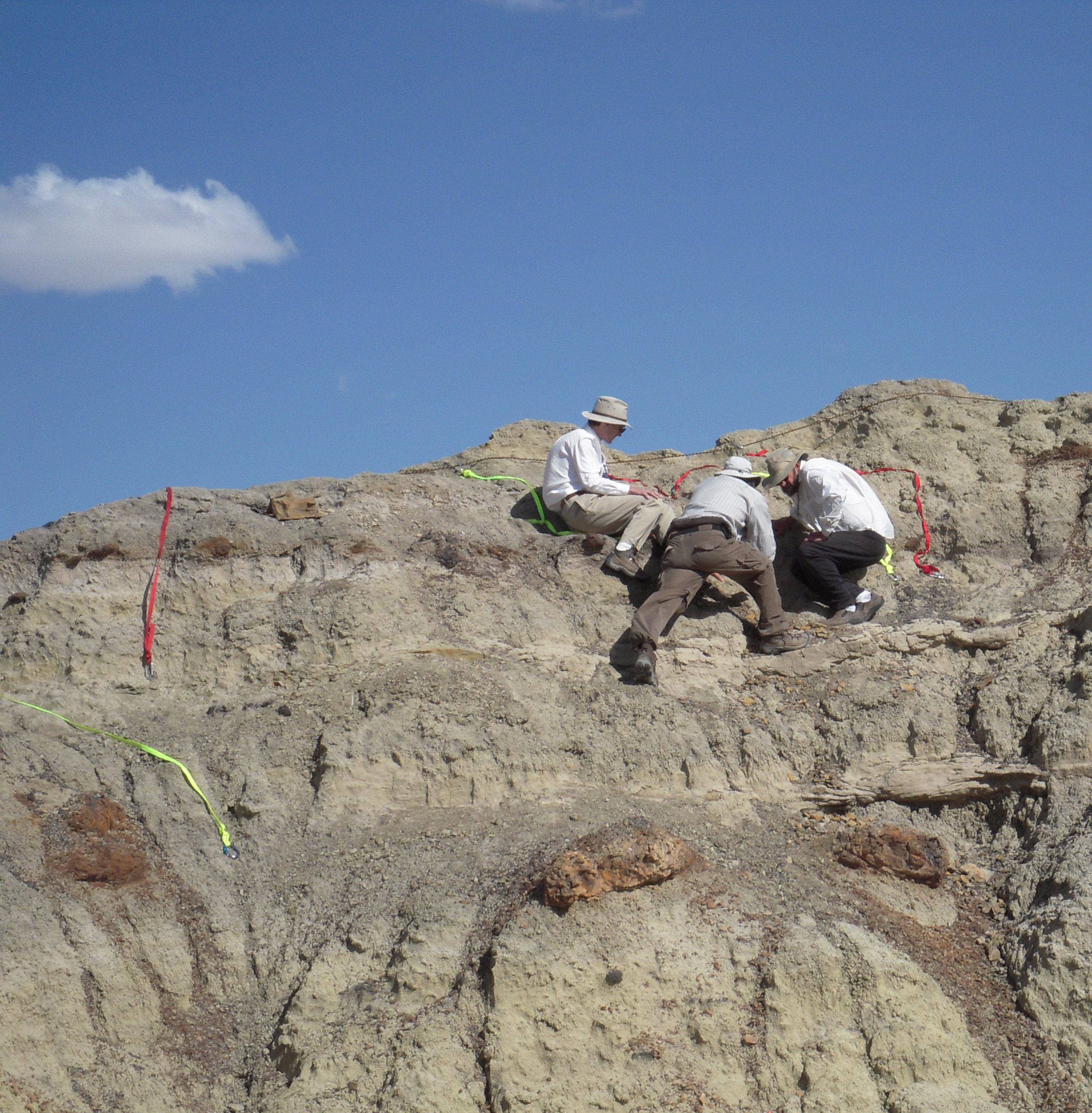 Apart from being a fascinating animal in itself, Invictarx is also the first new species of dinosaur named from the Menefee Formation, the rock layer in which it was discovered. It is the first of many fossil animals and plants from the Menefee that we will describe over the coming years. Of the three specimens, we chose one to serve as the holotype of Invictarx. The holotype of an organism, living or extinct, is the specimen to which the organism's scientific name will always be attached. It serves as the standard by which all future discoveries will be assessed as to whether they represent the same species as the holotype or not. The holotype is accessioned here at the Western Science Center, and is the first holotype in our collections.
Apart from being a fascinating animal in itself, Invictarx is also the first new species of dinosaur named from the Menefee Formation, the rock layer in which it was discovered. It is the first of many fossil animals and plants from the Menefee that we will describe over the coming years. Of the three specimens, we chose one to serve as the holotype of Invictarx. The holotype of an organism, living or extinct, is the specimen to which the organism's scientific name will always be attached. It serves as the standard by which all future discoveries will be assessed as to whether they represent the same species as the holotype or not. The holotype is accessioned here at the Western Science Center, and is the first holotype in our collections. 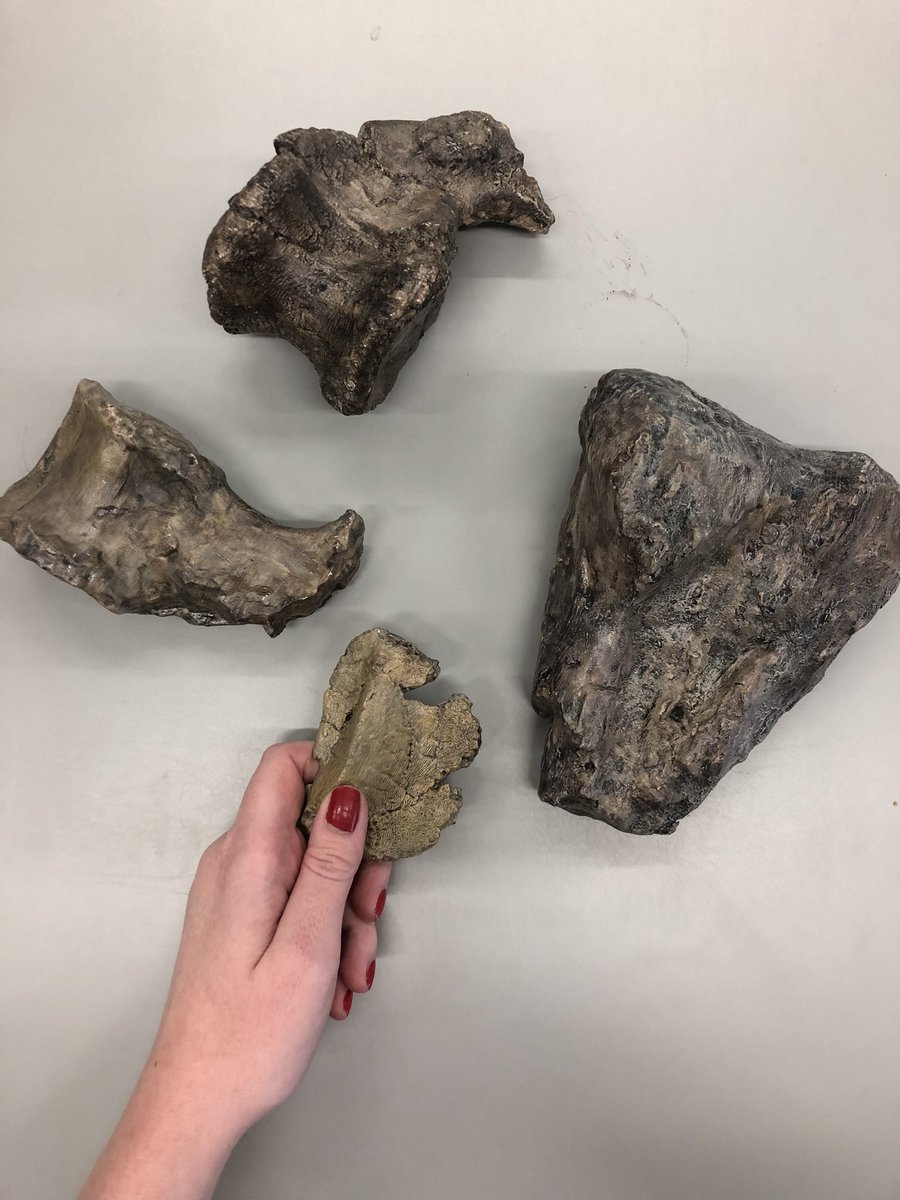 My colleagues and I return to New Mexico every summer to search for dinosaurs and other fossils in the Menefee Formation. We will very probably find additional fossils of Invictarx that will tell us more about its appearance and evolution. Naming it was really just the first step!Post by Curator Dr. Andrew McDonald
My colleagues and I return to New Mexico every summer to search for dinosaurs and other fossils in the Menefee Formation. We will very probably find additional fossils of Invictarx that will tell us more about its appearance and evolution. Naming it was really just the first step!Post by Curator Dr. Andrew McDonald
Fossil Friday - mastodon skull
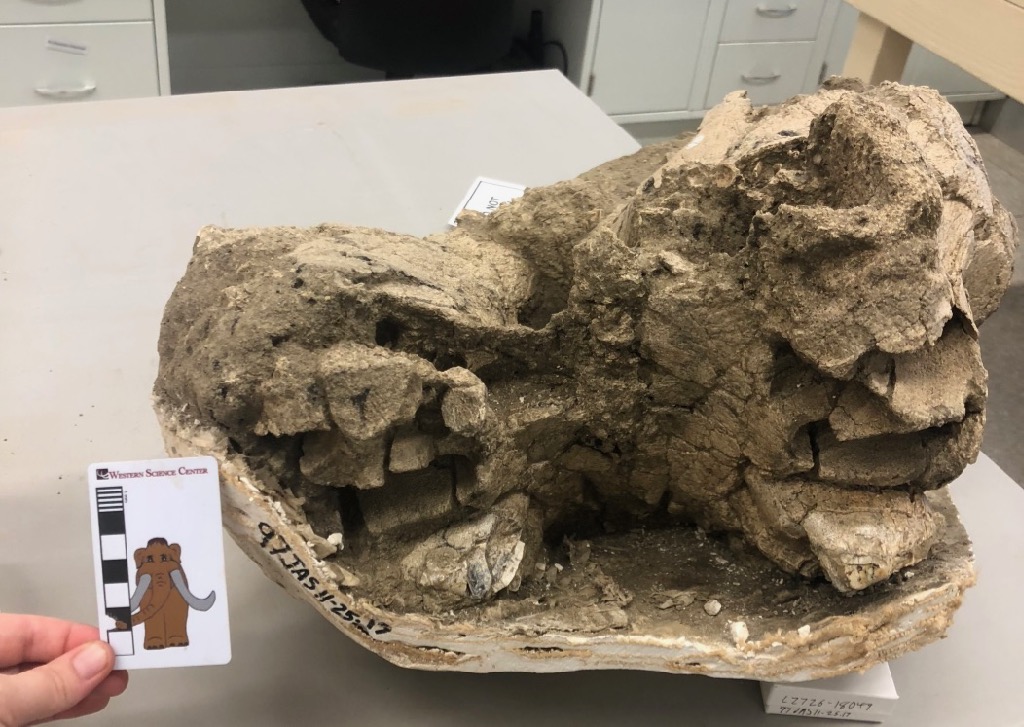 We haven't talked much about mastodons on the blog lately, but that doesn't mean they've been forgotten. We've been doing a lot of work scanning, measuring, and otherwise documenting the mastodons in our collection, and we're doing additional preparation work on some of them. The specimen featured in this week's post was moved into our preparation lab a few days ago for additional work.This may seem at first glance like a nondescript lump of bone, but it's actually a fairly significant amount of a small mastodon skull. This is an unusual view, looking head-on almost straight into the mouth. Below is an annotated version:
We haven't talked much about mastodons on the blog lately, but that doesn't mean they've been forgotten. We've been doing a lot of work scanning, measuring, and otherwise documenting the mastodons in our collection, and we're doing additional preparation work on some of them. The specimen featured in this week's post was moved into our preparation lab a few days ago for additional work.This may seem at first glance like a nondescript lump of bone, but it's actually a fairly significant amount of a small mastodon skull. This is an unusual view, looking head-on almost straight into the mouth. Below is an annotated version: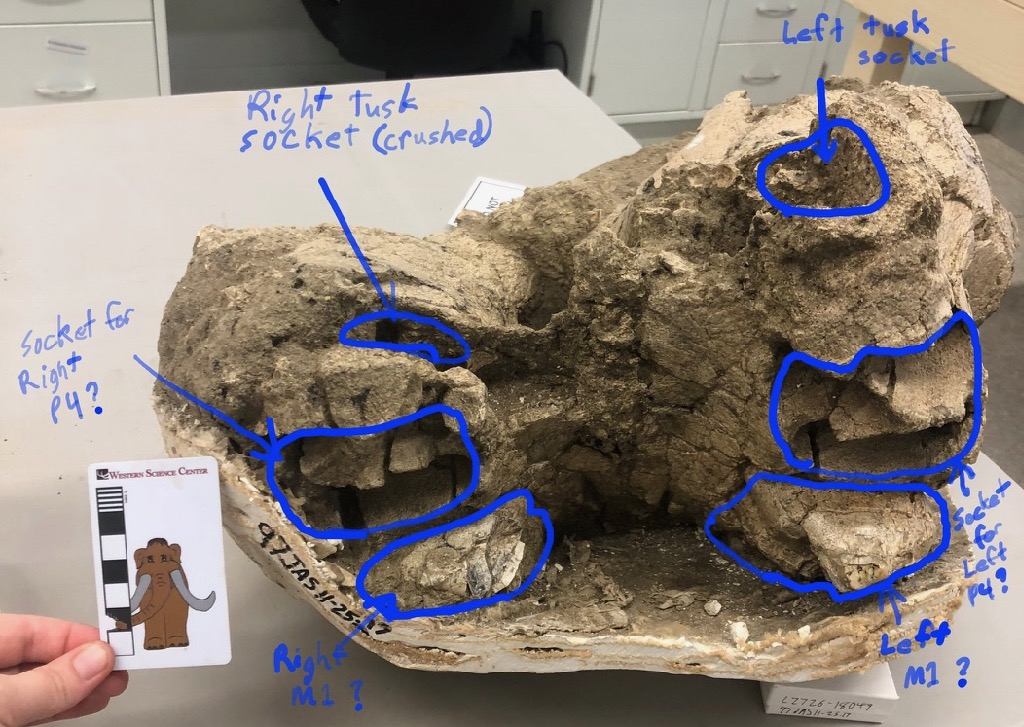 So we actually have nearly the entire palate of this animal, as well as the tusk sockets. Unfortunately, we can't see the teeth clearly because obscured by the plaster jacket, which is why we've moved this into the lab. We're going to try removing the jacket and cleaning the ventral side of the skull. That should enable us to determine if the preserved teeth are in fact the first molars (as suggested in the annotation), or whether they're actually the second molars.Determining the identification of this tooth has broad implications for this specimen. If you noticed the scale bar, you might have realized that this is a very small skull for a mastodon. If the tooth is the 1st molar, that means this mastodon was only about 14-15 years old, a young adolescent. But if it's the 2nd molar, it means that the mastodon was more like 27-28 years old, a full grown adult. To be that small at that age, this would have to be a female (male mastodons are much larger than females).Both female and juvenile mastodons are exceptionally rare from Diamond Valley Lake. In fact, whichever this specimen turns out to be, it will be the only skull from DVL in that category. So, female or juvenile? As soon as we find out, we'll let you know in a future post.
So we actually have nearly the entire palate of this animal, as well as the tusk sockets. Unfortunately, we can't see the teeth clearly because obscured by the plaster jacket, which is why we've moved this into the lab. We're going to try removing the jacket and cleaning the ventral side of the skull. That should enable us to determine if the preserved teeth are in fact the first molars (as suggested in the annotation), or whether they're actually the second molars.Determining the identification of this tooth has broad implications for this specimen. If you noticed the scale bar, you might have realized that this is a very small skull for a mastodon. If the tooth is the 1st molar, that means this mastodon was only about 14-15 years old, a young adolescent. But if it's the 2nd molar, it means that the mastodon was more like 27-28 years old, a full grown adult. To be that small at that age, this would have to be a female (male mastodons are much larger than females).Both female and juvenile mastodons are exceptionally rare from Diamond Valley Lake. In fact, whichever this specimen turns out to be, it will be the only skull from DVL in that category. So, female or juvenile? As soon as we find out, we'll let you know in a future post.
Fossil Friday - ceratopsian horn core
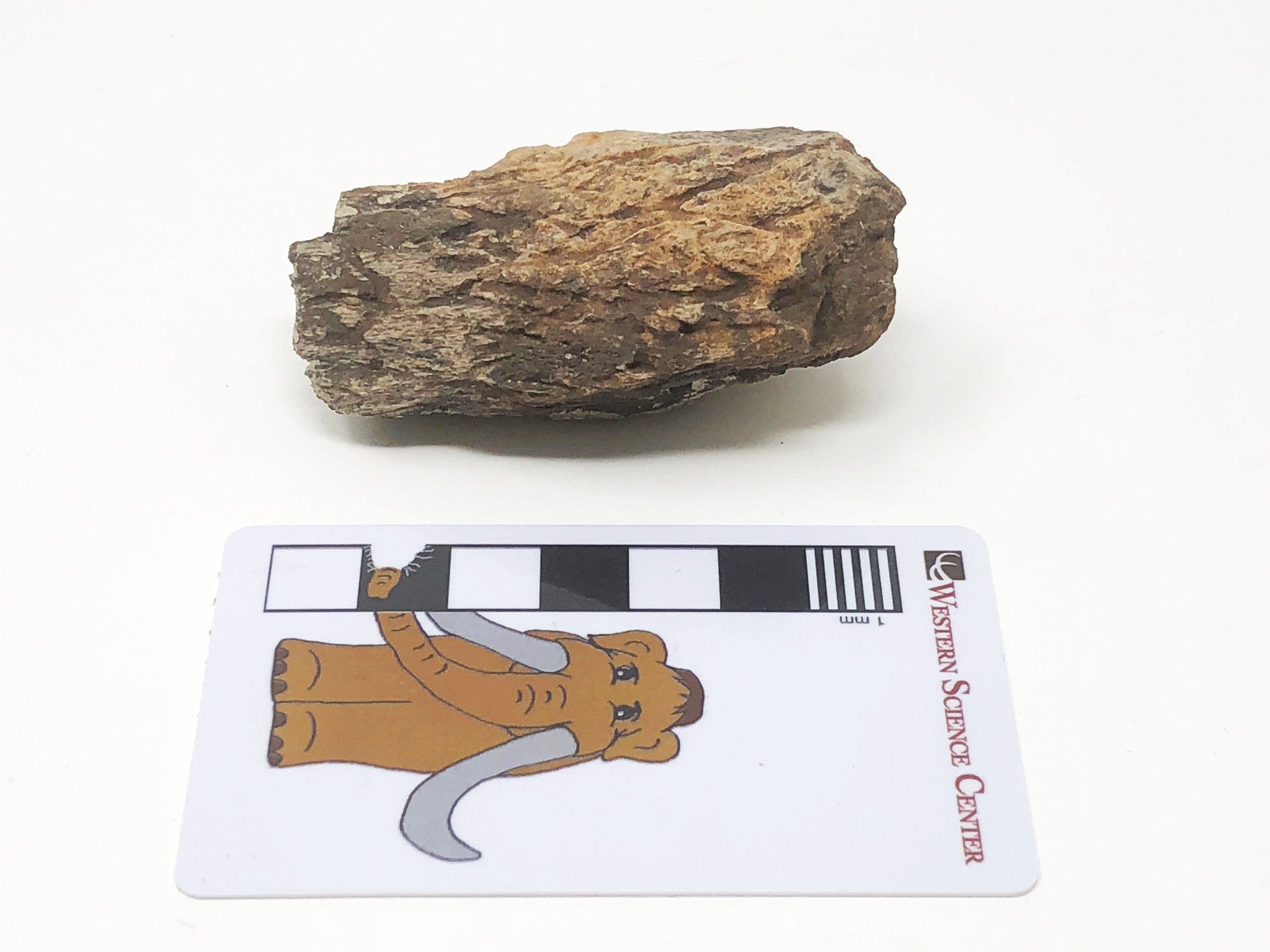 After a successful expedition earlier this summer, the Western Science Center crew returned to the Menefee Formation of New Mexico last week to search for more fossils of dinosaurs and other creatures that roamed the area 80 million years ago. As before, we were joined by colleagues from the Zuni Dinosaur Institute for Geosciences, students from the University of Arizona - Tucson, and volunteers from the Southwest Paleontological Society. Unlike the first trip, when we spent most of our time digging at two dinosaur quarries, this trip was mostly spent exploring for new fossil sites.This bone fragment is one of the pieces we collected while prospecting. The outer surface of this piece is riddled with deep branching grooves. This sort of texture is present only on the bony horn cores of ceratopsids, the big horned dinosaurs, such as Triceratops. When the dinosaur was alive, these grooves would have been occupied by blood vessels supplying the sheath of keratin (think fingernails) that covered the bony horn core. The photo shows the Menefee horn core fragment next to the brow horns of Ava, a horned dinosaur skull on display in WSC's "Great Wonders" exhibit. Ava's horns have the same texture.
After a successful expedition earlier this summer, the Western Science Center crew returned to the Menefee Formation of New Mexico last week to search for more fossils of dinosaurs and other creatures that roamed the area 80 million years ago. As before, we were joined by colleagues from the Zuni Dinosaur Institute for Geosciences, students from the University of Arizona - Tucson, and volunteers from the Southwest Paleontological Society. Unlike the first trip, when we spent most of our time digging at two dinosaur quarries, this trip was mostly spent exploring for new fossil sites.This bone fragment is one of the pieces we collected while prospecting. The outer surface of this piece is riddled with deep branching grooves. This sort of texture is present only on the bony horn cores of ceratopsids, the big horned dinosaurs, such as Triceratops. When the dinosaur was alive, these grooves would have been occupied by blood vessels supplying the sheath of keratin (think fingernails) that covered the bony horn core. The photo shows the Menefee horn core fragment next to the brow horns of Ava, a horned dinosaur skull on display in WSC's "Great Wonders" exhibit. Ava's horns have the same texture. 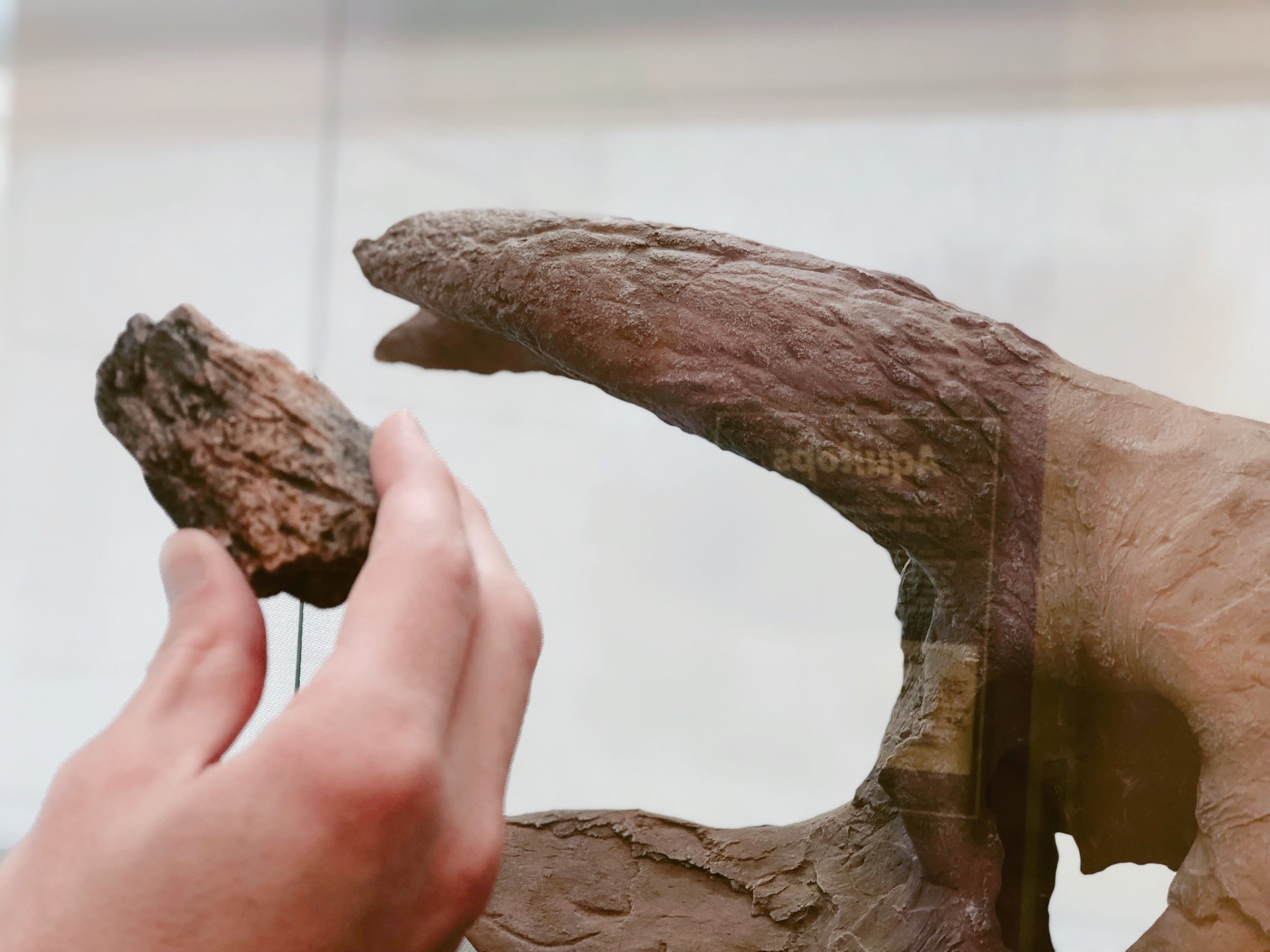 We will spend the next year preparing and studying the fossils we brought back from this summer's Menefee expeditions, and we will have much more to say about them in the very near future! Post by Curator Dr. Andrew McDonald
We will spend the next year preparing and studying the fossils we brought back from this summer's Menefee expeditions, and we will have much more to say about them in the very near future! Post by Curator Dr. Andrew McDonald
Fossil Friday - vole dentary
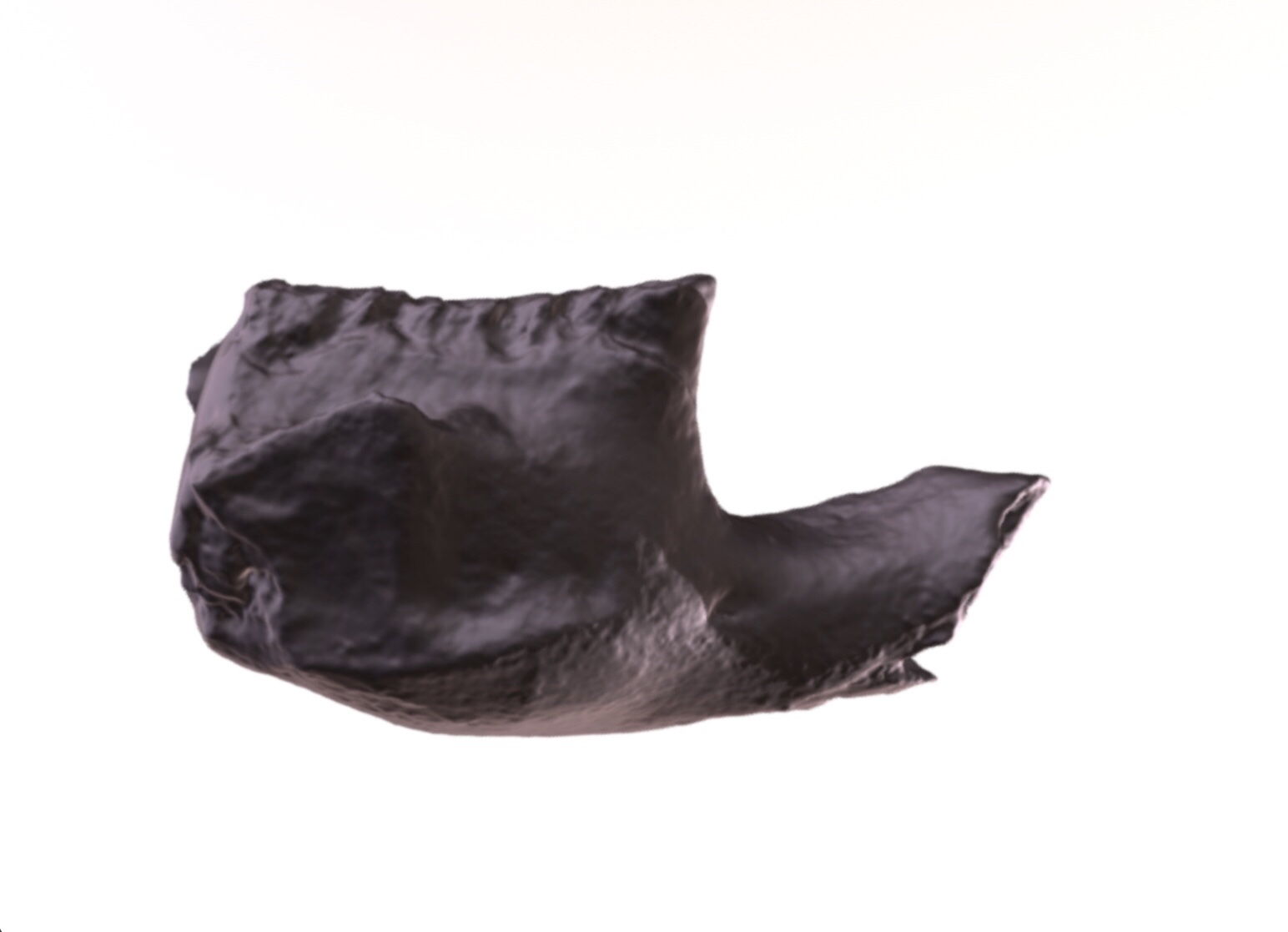 While other projects have taken priority in recent weeks, we've still been making steady progress on our small but diverse collection of fossil mammals for Harveston, at the northern end of Temecula. I recently purchased a new camera, and tested its macro capabilities by making a photogrammetric model or a rodent jaw. These images are screenshots of the resulting 3D model after uploading to Sketchfab. At top is lateral view, and below is occlusal:
While other projects have taken priority in recent weeks, we've still been making steady progress on our small but diverse collection of fossil mammals for Harveston, at the northern end of Temecula. I recently purchased a new camera, and tested its macro capabilities by making a photogrammetric model or a rodent jaw. These images are screenshots of the resulting 3D model after uploading to Sketchfab. At top is lateral view, and below is occlusal: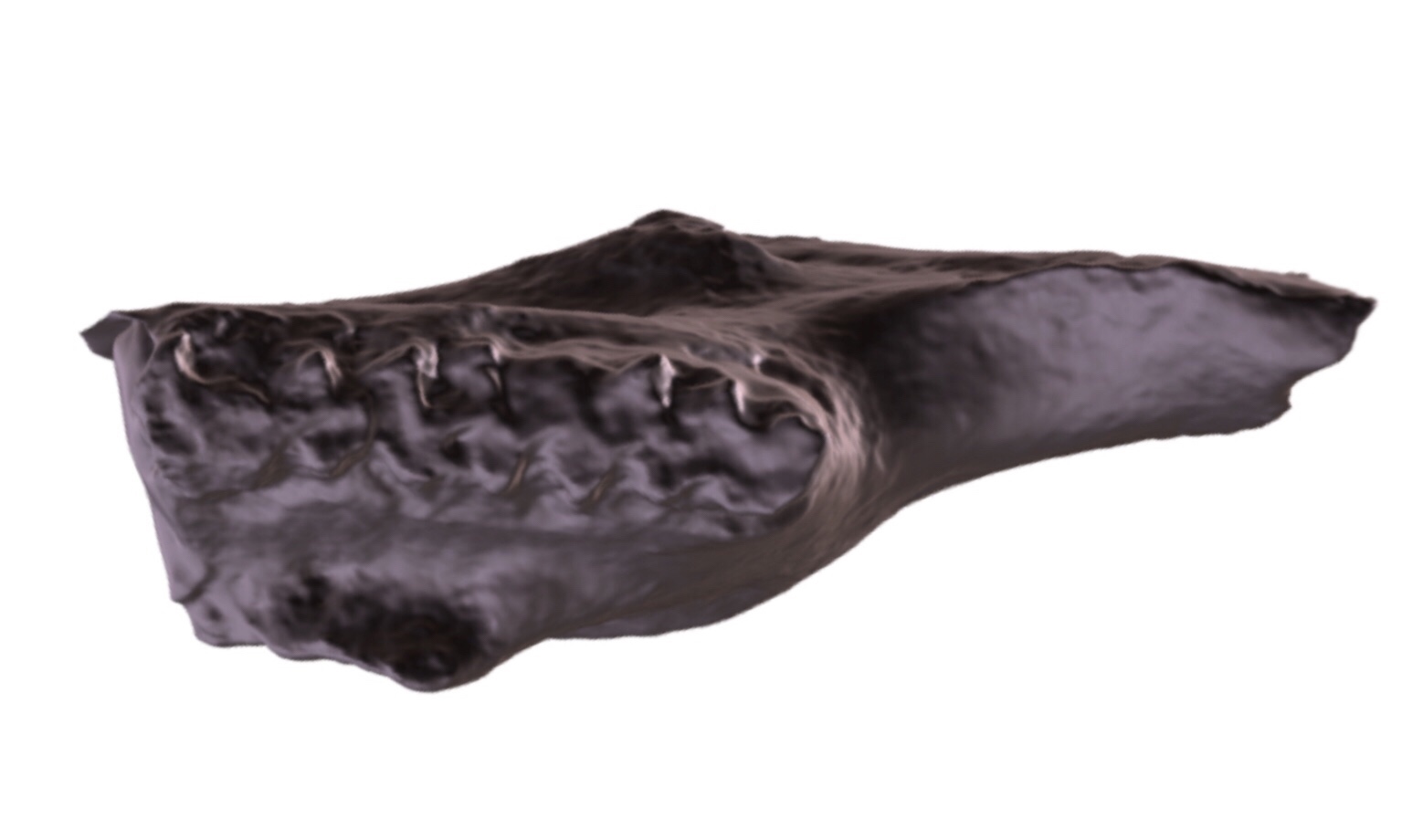 This is the anterior end of the right dentary. The 1st and 2nd molars are present, but the exposed part of the incisor is broken off, as is everything posterior to the 2nd molar. The enamel pattern on the occlusal surface of the teeth is typical of cricetid rodents, specifically voles of the genus Microtus. So far Microtus is the only genus of rodent we've positively identified from Harveston.The 3D model is available as a free download at Sketchfab: https://skfb.ly/6AHuK
This is the anterior end of the right dentary. The 1st and 2nd molars are present, but the exposed part of the incisor is broken off, as is everything posterior to the 2nd molar. The enamel pattern on the occlusal surface of the teeth is typical of cricetid rodents, specifically voles of the genus Microtus. So far Microtus is the only genus of rodent we've positively identified from Harveston.The 3D model is available as a free download at Sketchfab: https://skfb.ly/6AHuK
Fossil Friday - a whale for WSC
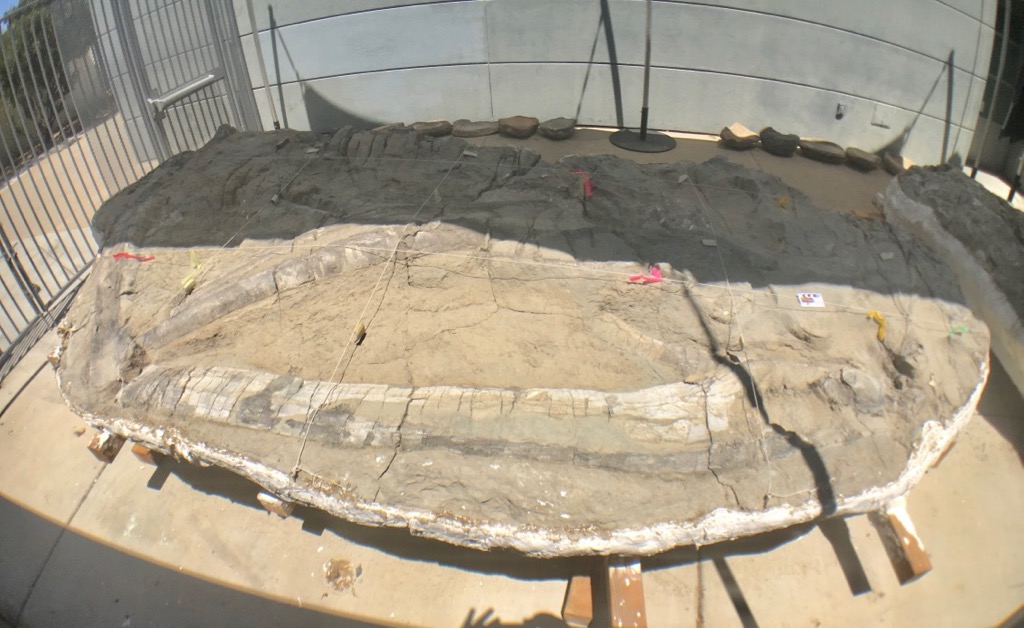 A few weeks ago, Western Science Center took delivery of the first fossil whale in our collection.This specimen was collected by PaleoSolutions during a construction project in Santa Cruz County. There are five separate field jackets, including one monster that's five meters long! That's the jacket shown above (notice the tiny scale bar on the right).This whale was found in Pliocene deposits, between 2 and 5 million years old. California has rich deposits of Pliocene whales, so when we've finished preparing this specimen (likely several years from now) there should be a lot with which to compare it. But even now, we can say a few things about it. First, this is a filter-feeding baleen whale from the suborder Mysticeti (hence the publicly-nominated nickname, Mystic). The only toothed whales (odontocetes) that get this large are sperm whales, and none of the visible cranial bones resembles the highly specialized elements in sperm whales. Below is a marked-up image with a few of the visible bones outlined (apologies for the lighting):
A few weeks ago, Western Science Center took delivery of the first fossil whale in our collection.This specimen was collected by PaleoSolutions during a construction project in Santa Cruz County. There are five separate field jackets, including one monster that's five meters long! That's the jacket shown above (notice the tiny scale bar on the right).This whale was found in Pliocene deposits, between 2 and 5 million years old. California has rich deposits of Pliocene whales, so when we've finished preparing this specimen (likely several years from now) there should be a lot with which to compare it. But even now, we can say a few things about it. First, this is a filter-feeding baleen whale from the suborder Mysticeti (hence the publicly-nominated nickname, Mystic). The only toothed whales (odontocetes) that get this large are sperm whales, and none of the visible cranial bones resembles the highly specialized elements in sperm whales. Below is a marked-up image with a few of the visible bones outlined (apologies for the lighting):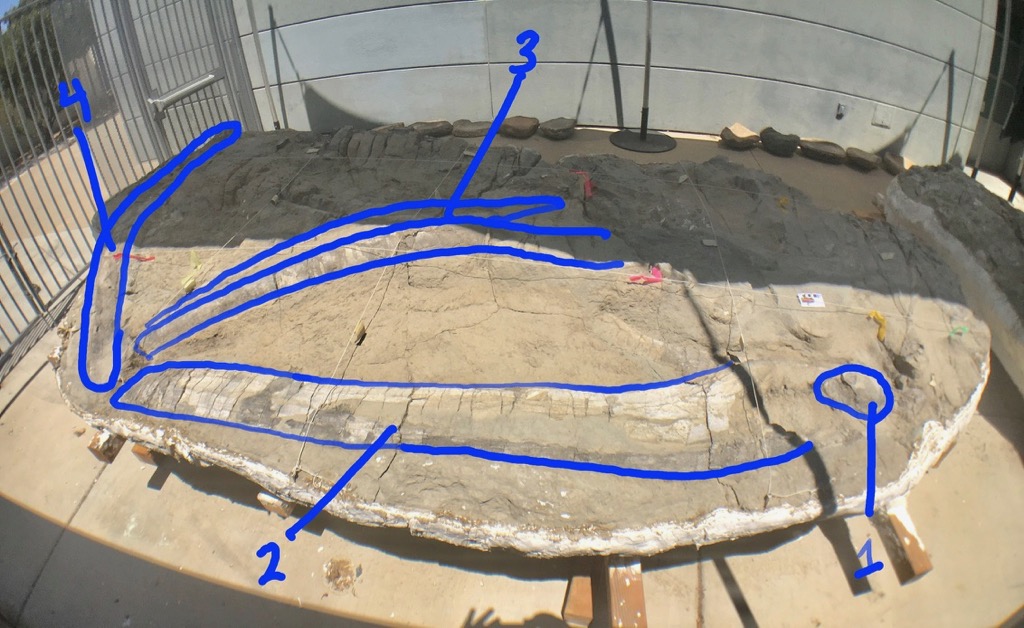 The bone labeled "1" is a vertebra, probably a thoracic or lumbar vertebra. This specimen includes numerous vertebrae, and all of them seem to have fused vertebral epiphyses, indicating that the whale is an adult.Number 2 is the left dentary; the left side of the lower jaw. It's not clear yet how much of the dentary is preserved, so it may be a bit longer than what is visible here. An interesting and important feature is the apparent absence of a coronoid process. The largest living group of baleen whales, the Balaenopteridae (including blue, fin, and humpback whales, among others) all have a large, prominent coronoid process. That means this specimen is more likely member of the right whale family (Balaenidae) or the grey whale family (Eschrichtiidae). (The weird pygmy right whale also lacks a coronoid process, and may not even be a right whale, but Mystic is not a pygmy right whale.)Number 3 I think are the premaxillae, which in whales extend from the tip of the upper jaw all the way to near the blowhole. These are strongly arched, which is consistent with both right whales and grey whales, but to me these look a bit more like a right whale.Number 4 I'm not sure about. I briefly thought is might be the broken continuation of the dentary, but I don't think that's right. The shape is wrong, and if you add that to bone 2 the dentary would be up in the blue whale-size range; Mystic isn't that big! I now think this might be the displaced and rotated maxilla. It should be running parallel to the premaxilla, so if it really is the maxilla it is way out of position, but this isn't unheard of. That shape is also consistent with a right whale maxilla.So, if this is a right whale (by no means a certainty), which right whale is it? There are actually only a handful of fossil right whale genera known. Of the four Pliocene genera, tiny Balaenella is only known from northern Europe, and is smaller than Mystic. Balaena includes the living bowhead whale as well as some extinct species. Eubalaena includes the three living right whale species, as well as several extinct ones. Most species of Balaena and Eubalaena are giants, quite a bit larger that Mystic (remember Mystic is an adult). I'm not ready to rule them out, but they seem unlikely. The fourth known Pliocene balaenid is Balaenula, a poorly understood genus that is known from all over the northern hemisphere, including California. Balaenula is a fairly small whale, and I think Mystic is likely a bit larger. But, if Mystic belongs to any right whale genus that has already been described, I think Balaenula is the best candidate.Mystic is on display in an outdoor preparation area at Western Science Center, so that the public can follow progress on its preparation in the years to come.
The bone labeled "1" is a vertebra, probably a thoracic or lumbar vertebra. This specimen includes numerous vertebrae, and all of them seem to have fused vertebral epiphyses, indicating that the whale is an adult.Number 2 is the left dentary; the left side of the lower jaw. It's not clear yet how much of the dentary is preserved, so it may be a bit longer than what is visible here. An interesting and important feature is the apparent absence of a coronoid process. The largest living group of baleen whales, the Balaenopteridae (including blue, fin, and humpback whales, among others) all have a large, prominent coronoid process. That means this specimen is more likely member of the right whale family (Balaenidae) or the grey whale family (Eschrichtiidae). (The weird pygmy right whale also lacks a coronoid process, and may not even be a right whale, but Mystic is not a pygmy right whale.)Number 3 I think are the premaxillae, which in whales extend from the tip of the upper jaw all the way to near the blowhole. These are strongly arched, which is consistent with both right whales and grey whales, but to me these look a bit more like a right whale.Number 4 I'm not sure about. I briefly thought is might be the broken continuation of the dentary, but I don't think that's right. The shape is wrong, and if you add that to bone 2 the dentary would be up in the blue whale-size range; Mystic isn't that big! I now think this might be the displaced and rotated maxilla. It should be running parallel to the premaxilla, so if it really is the maxilla it is way out of position, but this isn't unheard of. That shape is also consistent with a right whale maxilla.So, if this is a right whale (by no means a certainty), which right whale is it? There are actually only a handful of fossil right whale genera known. Of the four Pliocene genera, tiny Balaenella is only known from northern Europe, and is smaller than Mystic. Balaena includes the living bowhead whale as well as some extinct species. Eubalaena includes the three living right whale species, as well as several extinct ones. Most species of Balaena and Eubalaena are giants, quite a bit larger that Mystic (remember Mystic is an adult). I'm not ready to rule them out, but they seem unlikely. The fourth known Pliocene balaenid is Balaenula, a poorly understood genus that is known from all over the northern hemisphere, including California. Balaenula is a fairly small whale, and I think Mystic is likely a bit larger. But, if Mystic belongs to any right whale genus that has already been described, I think Balaenula is the best candidate.Mystic is on display in an outdoor preparation area at Western Science Center, so that the public can follow progress on its preparation in the years to come.
Fossil Friday - softshell turtle
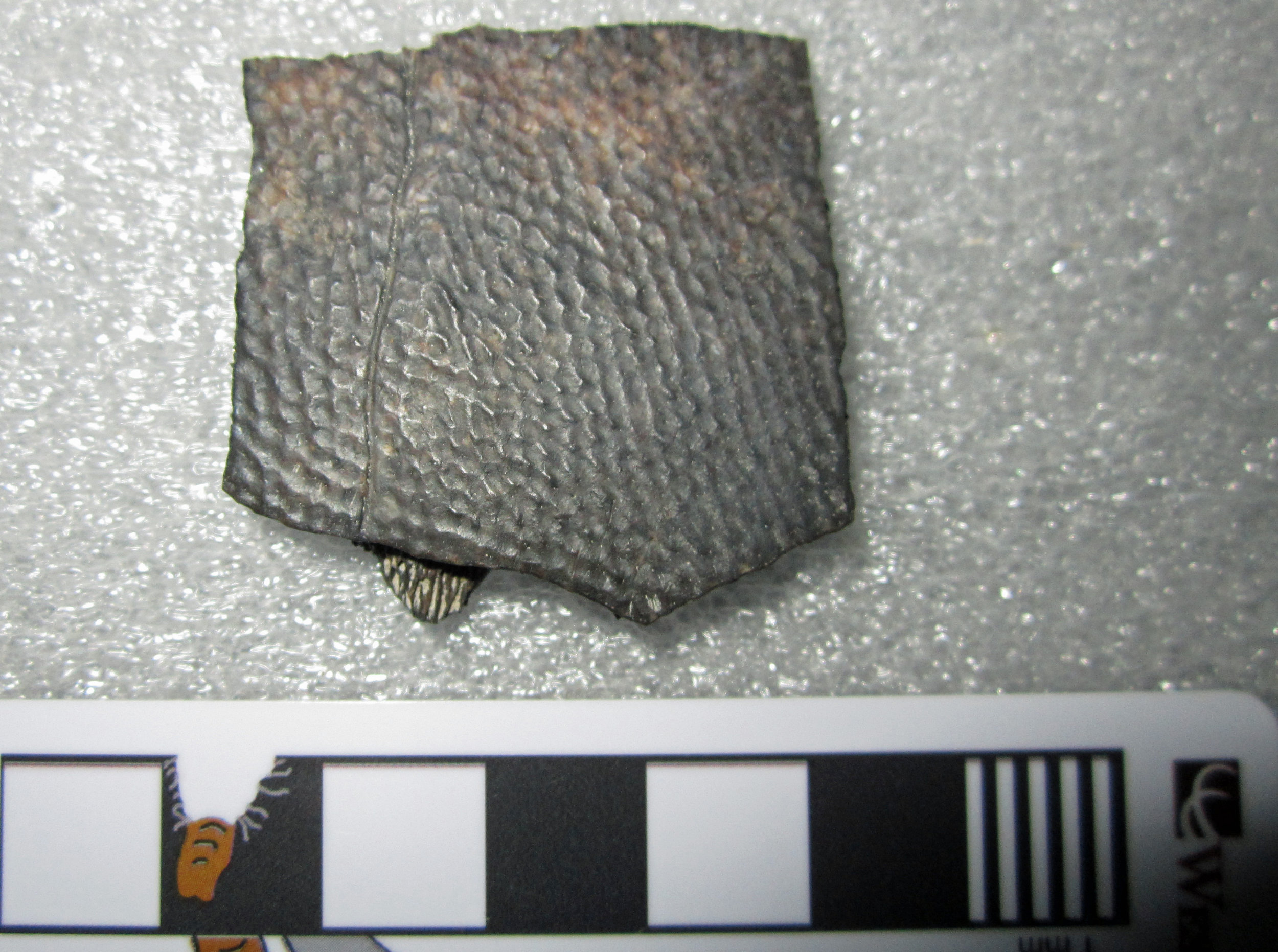 Turtles have a long and amazing fossil record, appearing around 260 million years ago, even before the earliest-known dinosaurs. By the latter most part of the age of dinosaurs, the Late Cretaceous Epoch, most of the modern turtle groups had evolved. Their fossils are extremely common in rocks that represent both freshwater and marine environments.Today's Fossil Friday is a piece of turtle shell that was collected by my colleagues and I in 2017 in the Menefee Formation of New Mexico. The shallow pits covering the surface suggest that it belongs to a trionychid - a softshell turtle, much like those that still live in North America today. This 80-million-year-old turtle was found at a diverse fossil site that also produced dinosaur bones, crocodile teeth, and large fish scales. These fossils were deposited in a freshwater environment, on a muddy floodplain near a slow-moving river.This is one of many turtle fossils discovered in the Menefee Formation by the Western Science Center, Zuni Dinosaur Institute for Geosciences, and Southwest Paleontological Society. We will have much more to say about them in the not too distant future! Post by Curator Dr. Andrew McDonald
Turtles have a long and amazing fossil record, appearing around 260 million years ago, even before the earliest-known dinosaurs. By the latter most part of the age of dinosaurs, the Late Cretaceous Epoch, most of the modern turtle groups had evolved. Their fossils are extremely common in rocks that represent both freshwater and marine environments.Today's Fossil Friday is a piece of turtle shell that was collected by my colleagues and I in 2017 in the Menefee Formation of New Mexico. The shallow pits covering the surface suggest that it belongs to a trionychid - a softshell turtle, much like those that still live in North America today. This 80-million-year-old turtle was found at a diverse fossil site that also produced dinosaur bones, crocodile teeth, and large fish scales. These fossils were deposited in a freshwater environment, on a muddy floodplain near a slow-moving river.This is one of many turtle fossils discovered in the Menefee Formation by the Western Science Center, Zuni Dinosaur Institute for Geosciences, and Southwest Paleontological Society. We will have much more to say about them in the not too distant future! Post by Curator Dr. Andrew McDonald
Fossil Friday - hadrosaur tibia
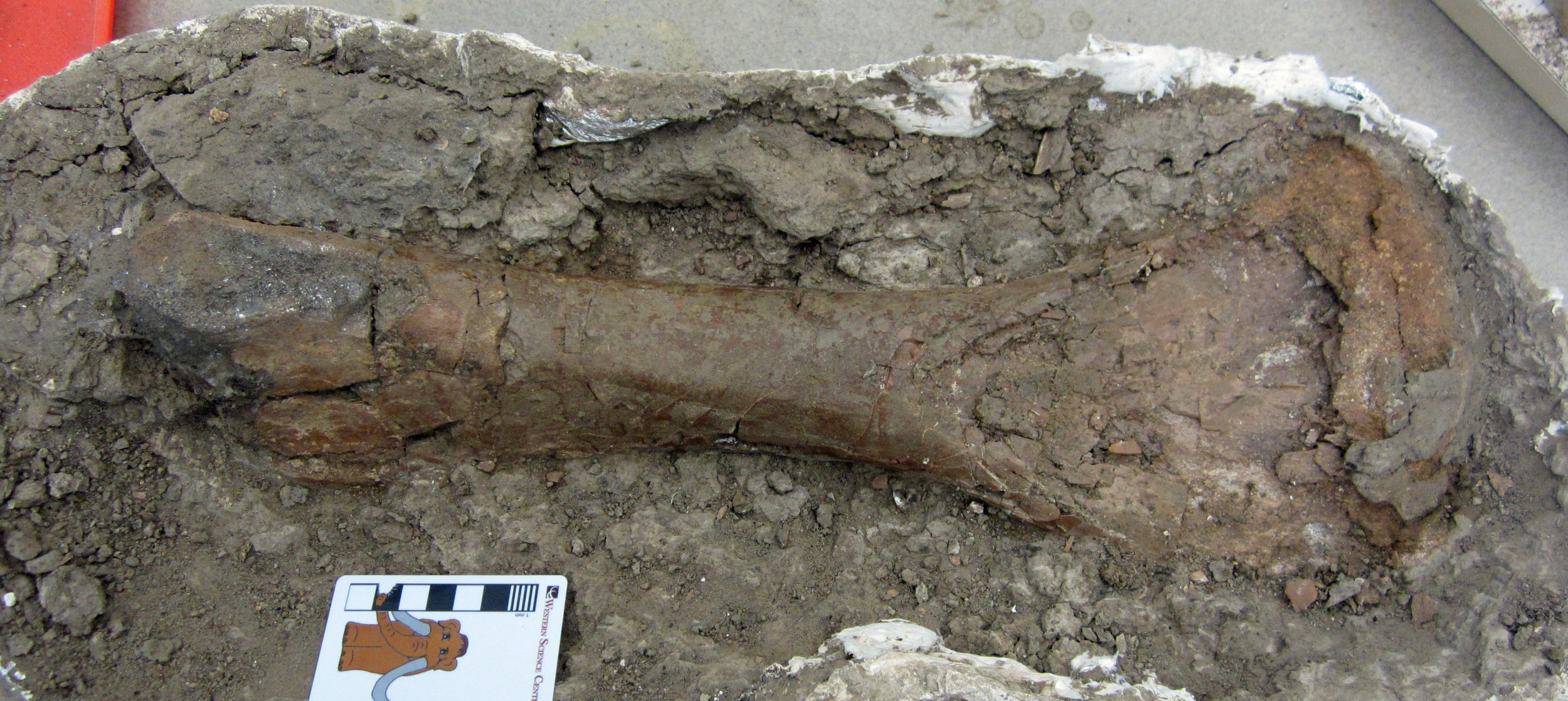 So far, most of the Late Cretaceous fossils I have shared with you for Fossil Friday have been from the Hell Creek Formation of Montana and were collected over a number of years by the late Harley Garbani. The Hell Creek dates to the very end of the age of dinosaurs, just before the mass extinction 66 million years ago.There are more Hell Creek fossils at WSC to share, but today I want to showcase another fossil from a somewhat older slice of the Late Cretaceous. Last month, I showed you some plant fossils from our field area in New Mexico. Today's fossil is the tibia of a plant-eating dinosaur, probably a young hadrosaur, one of the duck-billed dinosaurs. This bone was found by University of Arizona - Tucson paleontology undergrad Kara Kelley and is now being prepared at WSC by volunteer Joe Reavis.This bone was collected from the Menefee Formation of New Mexico, and is around 80 million years old. We are now preparing and studying this bone and many other fossils collected by the Western Science Center, our partners at the Zuni Dinosaur Institute of Geosciences in Springerville, AZ, and volunteers from the Southwest Paleontological Society. We had a very successful expedition to the Menefee Formation in May-June; you can read an account of it written by yours truly. And we'll undertake another round of field work in the Menefee in August!Post by Curator Dr. Andrew McDonald
So far, most of the Late Cretaceous fossils I have shared with you for Fossil Friday have been from the Hell Creek Formation of Montana and were collected over a number of years by the late Harley Garbani. The Hell Creek dates to the very end of the age of dinosaurs, just before the mass extinction 66 million years ago.There are more Hell Creek fossils at WSC to share, but today I want to showcase another fossil from a somewhat older slice of the Late Cretaceous. Last month, I showed you some plant fossils from our field area in New Mexico. Today's fossil is the tibia of a plant-eating dinosaur, probably a young hadrosaur, one of the duck-billed dinosaurs. This bone was found by University of Arizona - Tucson paleontology undergrad Kara Kelley and is now being prepared at WSC by volunteer Joe Reavis.This bone was collected from the Menefee Formation of New Mexico, and is around 80 million years old. We are now preparing and studying this bone and many other fossils collected by the Western Science Center, our partners at the Zuni Dinosaur Institute of Geosciences in Springerville, AZ, and volunteers from the Southwest Paleontological Society. We had a very successful expedition to the Menefee Formation in May-June; you can read an account of it written by yours truly. And we'll undertake another round of field work in the Menefee in August!Post by Curator Dr. Andrew McDonald
Fossil Friday - Coelacanth fossil
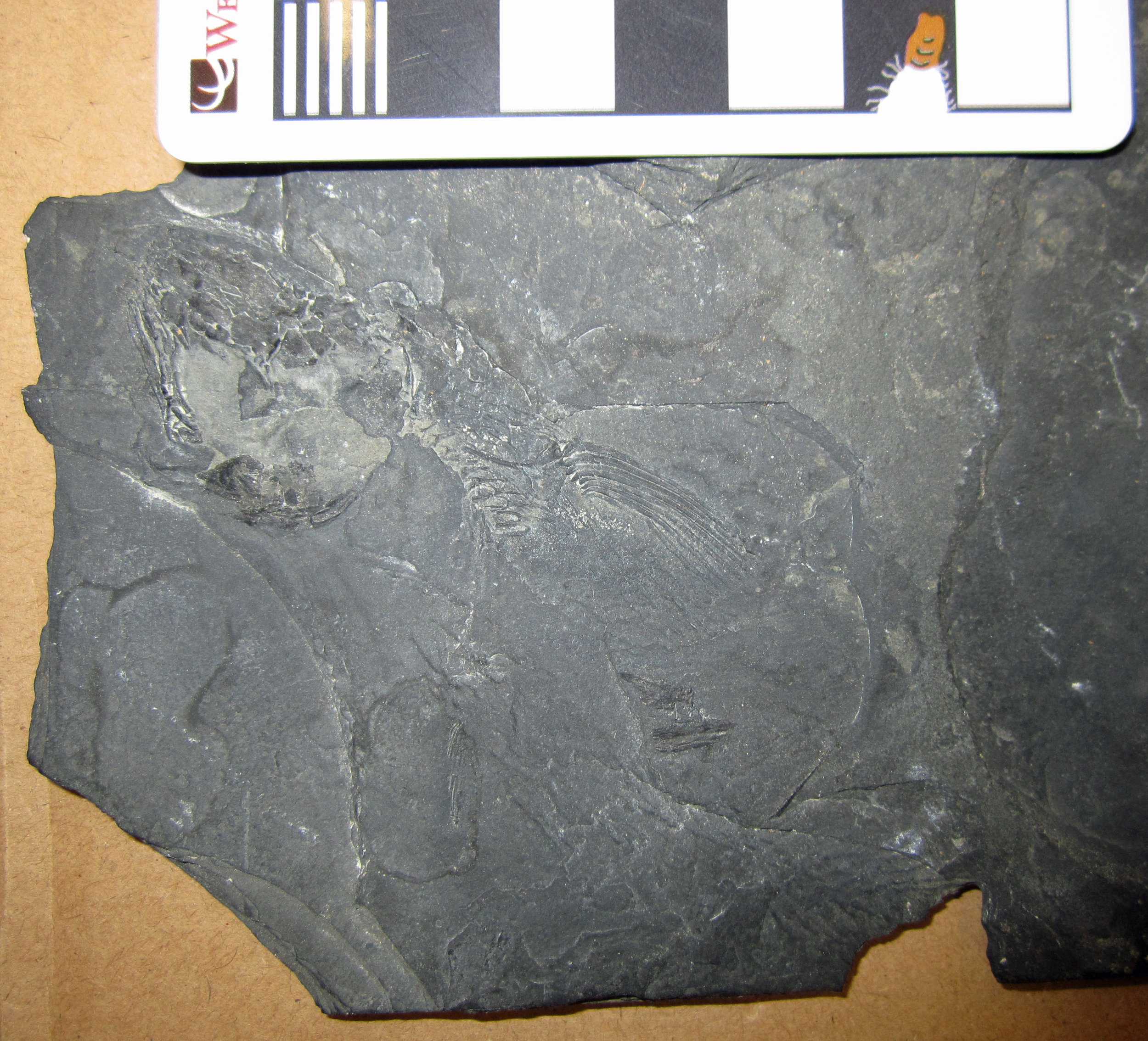 In 1938, Marjorie Courtenay-Latimer, a naturalist at the East London Museum in South Africa, discovered a bizarre fish in a fisherman's haul. This remarkable fish was later given the genus name Latimeria to honor the woman who first recognized its importance. Courtenay-Latimer's discovery was the first indication that an ancient type of fish, thought to have gone extinct at the end of the Cretaceous Period, was alive and well in the modern ocean. Latimeria is the living coelacanth.Coelacanths have a long fossil record, going all the way back to the Devonian Period, more than 400 million years ago. They were extremely successful, inhabiting both freshwater and saltwater, evolving a great range of body shapes, and in some cases, growing to huge sizes of 15 feet or more. The Western Science Center's coelacanth fossil was discovered in New Jersey by the late fossil collector Harley Garbani and donated to the museum by his wife, Mary Garbani.This little fossil fish probably belongs to the genus Diplurus, which lived during the Early Jurassic Epoch, around 200 million years ago. In the photo, the skull is towards the upper left, with the tail in the bottom right. Part of the vertebral column is visible behind the skull, as well as parts of at least two fins. The second photo is a much more complete specimen of Diplurus, photographed by Alton Dooley at the Cleveland Museum of Natural History, showing the full body shape.Post by Curator Dr. Andrew McDonald
In 1938, Marjorie Courtenay-Latimer, a naturalist at the East London Museum in South Africa, discovered a bizarre fish in a fisherman's haul. This remarkable fish was later given the genus name Latimeria to honor the woman who first recognized its importance. Courtenay-Latimer's discovery was the first indication that an ancient type of fish, thought to have gone extinct at the end of the Cretaceous Period, was alive and well in the modern ocean. Latimeria is the living coelacanth.Coelacanths have a long fossil record, going all the way back to the Devonian Period, more than 400 million years ago. They were extremely successful, inhabiting both freshwater and saltwater, evolving a great range of body shapes, and in some cases, growing to huge sizes of 15 feet or more. The Western Science Center's coelacanth fossil was discovered in New Jersey by the late fossil collector Harley Garbani and donated to the museum by his wife, Mary Garbani.This little fossil fish probably belongs to the genus Diplurus, which lived during the Early Jurassic Epoch, around 200 million years ago. In the photo, the skull is towards the upper left, with the tail in the bottom right. Part of the vertebral column is visible behind the skull, as well as parts of at least two fins. The second photo is a much more complete specimen of Diplurus, photographed by Alton Dooley at the Cleveland Museum of Natural History, showing the full body shape.Post by Curator Dr. Andrew McDonald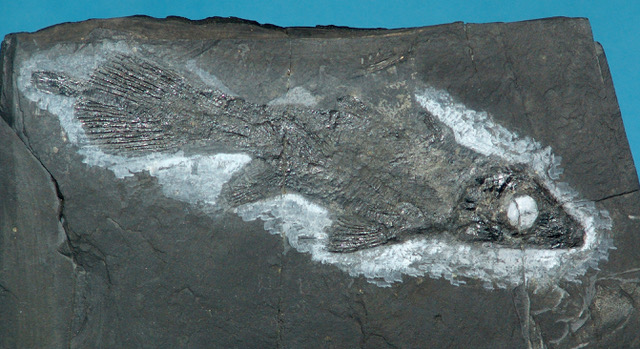
Fossil Friday - champsosaur vertebrae
 Driven by a surge in volcanic activity and a devastating asteroid impact, the mass extinction 66 million years ago was one of the most cataclysmic events in Earth's long history. On land and in the sea, vast numbers of animals and plants went extinct. Among the victims were the dinosaurs, except for modern birds; the great marine reptiles; and the ammonites, coil-shelled relatives of squid and octopus. Among the survivors were the ancestors of modern birds, crocodilians, mammals, and other organisms that would shape the ecology of the planet for the next 66 million years.However, not all the animal groups that survived through the mass extinction would make it to the present day. One such animal is Champsosaurus. Champsosaurus fossils are common in the western United States and Canada, in rocks that date to just before the mass extinction and just after the extinction. Champsosaurus hung on until around 55 million years ago, when it finally went extinct.These are four Champsosaurus vertebrae from the Hell Creek Formation of Montana, found by the late fossil collector Harley Garbani and donated to the Western Science Center by his wife, Mary Garbani. The two vertebrae on the left are shown in bottom view, and the two vertebrae on the right are in top view. Champsosaurus lived in freshwater and used its long toothy snout to catch fish and other prey. It could grow to around six feet long and was built a little like a small crocodile (example below from the Arizona Museum of Natural History):
Driven by a surge in volcanic activity and a devastating asteroid impact, the mass extinction 66 million years ago was one of the most cataclysmic events in Earth's long history. On land and in the sea, vast numbers of animals and plants went extinct. Among the victims were the dinosaurs, except for modern birds; the great marine reptiles; and the ammonites, coil-shelled relatives of squid and octopus. Among the survivors were the ancestors of modern birds, crocodilians, mammals, and other organisms that would shape the ecology of the planet for the next 66 million years.However, not all the animal groups that survived through the mass extinction would make it to the present day. One such animal is Champsosaurus. Champsosaurus fossils are common in the western United States and Canada, in rocks that date to just before the mass extinction and just after the extinction. Champsosaurus hung on until around 55 million years ago, when it finally went extinct.These are four Champsosaurus vertebrae from the Hell Creek Formation of Montana, found by the late fossil collector Harley Garbani and donated to the Western Science Center by his wife, Mary Garbani. The two vertebrae on the left are shown in bottom view, and the two vertebrae on the right are in top view. Champsosaurus lived in freshwater and used its long toothy snout to catch fish and other prey. It could grow to around six feet long and was built a little like a small crocodile (example below from the Arizona Museum of Natural History):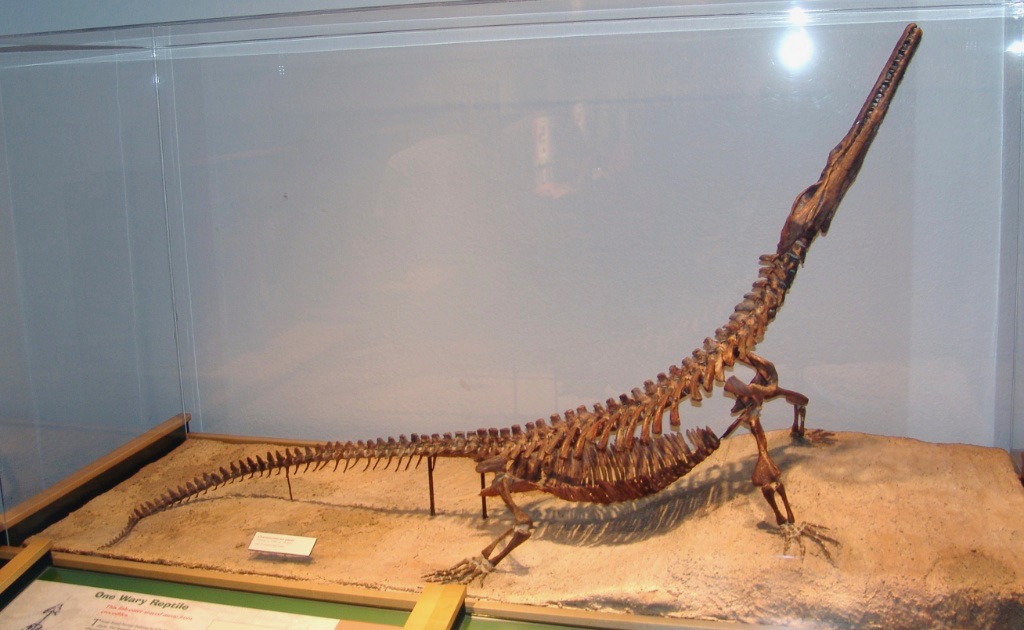
Fossil Friday - antilocaprid tooth
 Yesterday was World Giraffe Day. Giraffes are members of a once-large superfamily of artiodactyls called the Giraffoidea, that now includes only three extant genera: Giraffa, Okapaia (okapis), and Antilocapra (pronghorns). While giraffes and okapis are only found in the Old World, antilocaprids are native to North America.Antilocaprids have an extensive fossil record, as as recently as the Pleistocene they were much more diverse. Several species are known from the Pleistocene of Southern California, and there are a few specimens in the collections at the Western Science Center.
Yesterday was World Giraffe Day. Giraffes are members of a once-large superfamily of artiodactyls called the Giraffoidea, that now includes only three extant genera: Giraffa, Okapaia (okapis), and Antilocapra (pronghorns). While giraffes and okapis are only found in the Old World, antilocaprids are native to North America.Antilocaprids have an extensive fossil record, as as recently as the Pleistocene they were much more diverse. Several species are known from the Pleistocene of Southern California, and there are a few specimens in the collections at the Western Science Center. Above is a partial lower right third molar, seen in lingual view. This tooth is consistent with Antilocapra itself, but could also represent the similar-sized Tetrameryx, which is also known from the southwest. This tooth is our only record of an antilocaprid from the Late Pleistocene deposits in the Harveston neighborhood of Temecula, in southwestern Riverside County.We've made a 3D model of this tooth available for download at Sketchfab at https://skfb.ly.6zQBw.
Above is a partial lower right third molar, seen in lingual view. This tooth is consistent with Antilocapra itself, but could also represent the similar-sized Tetrameryx, which is also known from the southwest. This tooth is our only record of an antilocaprid from the Late Pleistocene deposits in the Harveston neighborhood of Temecula, in southwestern Riverside County.We've made a 3D model of this tooth available for download at Sketchfab at https://skfb.ly.6zQBw.
Fossil Friday - Palm Frond
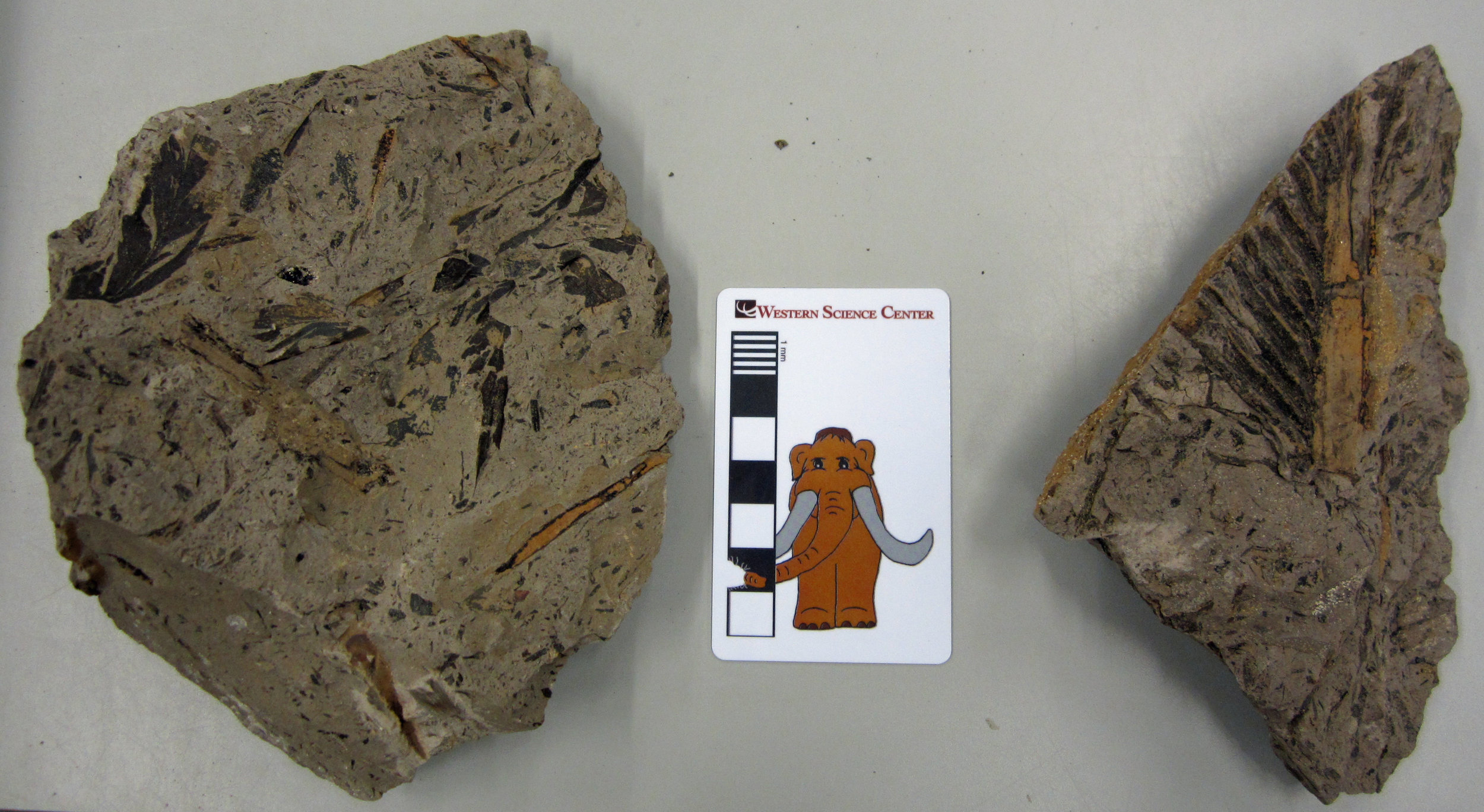 I just returned from 18 days of field work in the Upper Cretaceous Menefee Formation of New Mexico.A team of staff and volunteers from Western Science Center, Zuni Dinosaur Institute for Geosciences, and Southwest Paleontological Society collected over half a ton of fossils, including dinosaurs, crocodiles, and turtles. All these fossils will be prepped, curated, and studied at Western Science Center over the next few years.While digging through the hard mudstone layers of the Menefee Formation, we invariably encounter abundant plant fossils. Most of these consist of shards of stems and leaves, but many others should be identifiable. In this image are two pieces of mudstone collected at one of our dinosaur quarries. The piece on the left is covered in fragments of stems and leaves, with a more complete leaf in the upper left corner. On the right is a slice of mudstone with part of a palm leaf preserved.Fossil plants are an integral part of reconstructing and imagining ancient ecosystems. Analysis of plant fossils such as these will help reveal what the climate, environment, and ecology of the Menefee Formation were like 80 million years ago.Post by Curator Dr. Andrew T. McDonald.
I just returned from 18 days of field work in the Upper Cretaceous Menefee Formation of New Mexico.A team of staff and volunteers from Western Science Center, Zuni Dinosaur Institute for Geosciences, and Southwest Paleontological Society collected over half a ton of fossils, including dinosaurs, crocodiles, and turtles. All these fossils will be prepped, curated, and studied at Western Science Center over the next few years.While digging through the hard mudstone layers of the Menefee Formation, we invariably encounter abundant plant fossils. Most of these consist of shards of stems and leaves, but many others should be identifiable. In this image are two pieces of mudstone collected at one of our dinosaur quarries. The piece on the left is covered in fragments of stems and leaves, with a more complete leaf in the upper left corner. On the right is a slice of mudstone with part of a palm leaf preserved.Fossil plants are an integral part of reconstructing and imagining ancient ecosystems. Analysis of plant fossils such as these will help reveal what the climate, environment, and ecology of the Menefee Formation were like 80 million years ago.Post by Curator Dr. Andrew T. McDonald.
Fossil Friday - mastodon palate
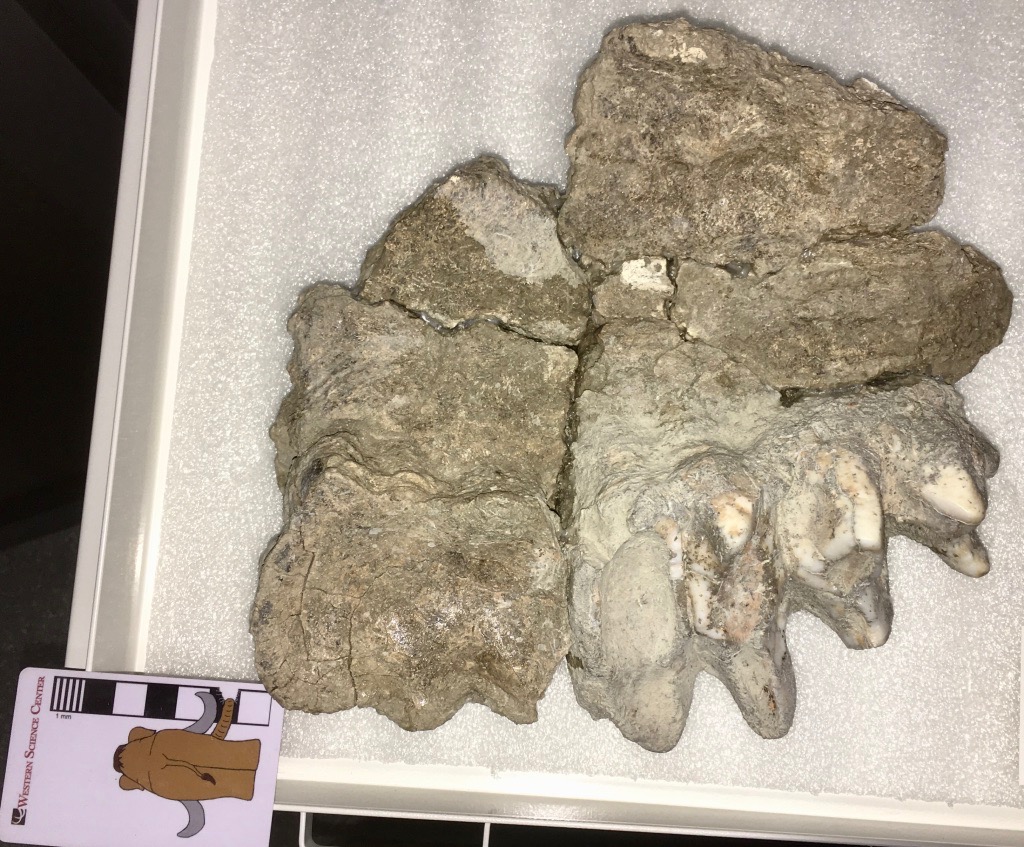 The Valley of the Mastodons exhibit has closed, and most of out mastodon remains have been moved back to the museum's repository. But that doesn't mean they're forgotten, or that work on them has stopped!This specimen is a fragment of a mastodon palate, with the anterior end on the left. Most of the left side of the palate is missing, but the right side (at the bottom of the image) includes the complete 2nd and 3rd molars. Even a small fragment like this tells us quite a bit about mastodons.Like other advanced proboscideans, mastodons replaced their teeth horizontally instead of vertically like most mammals. That means that during the mastodon's life it gradually works it's way through six teeth in each quarter jaw, one after another - the 2nd, 3rd, and 4th premolars, and the 1st, 2nd, and 3rd molars (we're ignoring the tusks here, which are also teeth). With this pattern of tooth replacement, by looking at which teeth are present in the mouth and how worn the teeth are, we can make a reasonably precise estimate of how old the mastodon was when it died.In 1966, British biologist Richard Laws published a detailed description of how tooth wear and replacement rates relate to age in African elephants, which has become the standard starting point for estimating proboscidean ages. He divided the elephant life cycle into 30 tooth wear stages, which are now called Laws groups. So, for example, an African elephant with the 4th premolar heavily worn and the 1st molar just about to erupt would be in Laws group VII, which would make it 6 years old, ± 1 year.With some limitations, this same system works pretty well for mastodons even though they're only distantly related to elephants. Because there is some uncertainty involved, when applied to extinct elephants the age indicated by the Laws group is usually expressed in terms of AEY (African Equivalent Years), the age that an African elephant would be in the same wear state.So how about this mastodon? The 2nd molar is still present, but is almost completely worn away; there is only a thin band of enamel remaining around the edges. The 3rd molar shows lots of wear on the 1st loph at the front of the tooth, somewhat less on the 2nd loph, light wear on the 3rd, and little or no wear on the 4th. That puts this mastodon into Laws group 22, with an age of 39 ± 2 AEY, a fully mature but not yet elderly mastodon. We actually have several mastodons from Diamond Valley Lake that fall into Laws group 22, including Max, our largest and best-preserved skull.This particular mastodon was discovered at the West Dam of Diamond Valley Lake, making it between about 14,000-20,000 years old. Reference:Laws, R. M., 1966. Age criteria for the African elephant, Loxodonta a. africana. East African Wildlife Journal 4:1-37.
The Valley of the Mastodons exhibit has closed, and most of out mastodon remains have been moved back to the museum's repository. But that doesn't mean they're forgotten, or that work on them has stopped!This specimen is a fragment of a mastodon palate, with the anterior end on the left. Most of the left side of the palate is missing, but the right side (at the bottom of the image) includes the complete 2nd and 3rd molars. Even a small fragment like this tells us quite a bit about mastodons.Like other advanced proboscideans, mastodons replaced their teeth horizontally instead of vertically like most mammals. That means that during the mastodon's life it gradually works it's way through six teeth in each quarter jaw, one after another - the 2nd, 3rd, and 4th premolars, and the 1st, 2nd, and 3rd molars (we're ignoring the tusks here, which are also teeth). With this pattern of tooth replacement, by looking at which teeth are present in the mouth and how worn the teeth are, we can make a reasonably precise estimate of how old the mastodon was when it died.In 1966, British biologist Richard Laws published a detailed description of how tooth wear and replacement rates relate to age in African elephants, which has become the standard starting point for estimating proboscidean ages. He divided the elephant life cycle into 30 tooth wear stages, which are now called Laws groups. So, for example, an African elephant with the 4th premolar heavily worn and the 1st molar just about to erupt would be in Laws group VII, which would make it 6 years old, ± 1 year.With some limitations, this same system works pretty well for mastodons even though they're only distantly related to elephants. Because there is some uncertainty involved, when applied to extinct elephants the age indicated by the Laws group is usually expressed in terms of AEY (African Equivalent Years), the age that an African elephant would be in the same wear state.So how about this mastodon? The 2nd molar is still present, but is almost completely worn away; there is only a thin band of enamel remaining around the edges. The 3rd molar shows lots of wear on the 1st loph at the front of the tooth, somewhat less on the 2nd loph, light wear on the 3rd, and little or no wear on the 4th. That puts this mastodon into Laws group 22, with an age of 39 ± 2 AEY, a fully mature but not yet elderly mastodon. We actually have several mastodons from Diamond Valley Lake that fall into Laws group 22, including Max, our largest and best-preserved skull.This particular mastodon was discovered at the West Dam of Diamond Valley Lake, making it between about 14,000-20,000 years old. Reference:Laws, R. M., 1966. Age criteria for the African elephant, Loxodonta a. africana. East African Wildlife Journal 4:1-37.
Fossil Friday - Triceratops Teeth
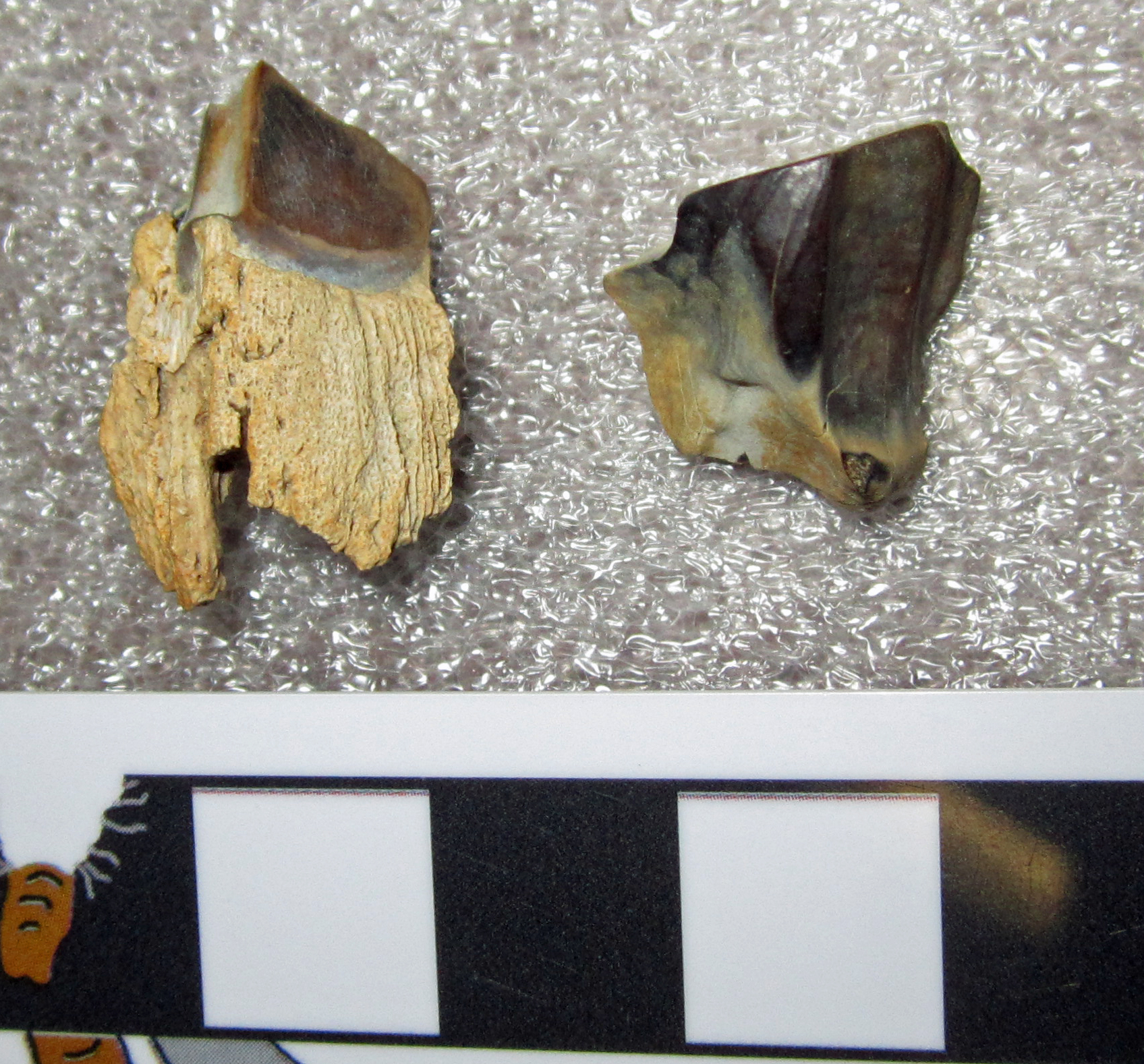 Dinosaurs evolved many amazing and sophisticated adaptations during their long history. One of the most remarkable is the ability of some plant-eating dinosaurs to chew their food. This feature evolved independently in the armored ankylosaurs, the thumb-spiked and duck-billed iguanodonts, and the horned ceratopsians. In a recent open-access study, Erickson et al. (2015) examined the teeth of the famous ceratopsian Triceratops for clues as to how they functioned in feeding. This paper is available here: http://advances.sciencemag.org/content/1/5/e1500055.fullErickson et al. found that the teeth of Triceratops wore down to form a sharp cutting edge over time and with use, allowing the animal to chew resilient plants. As the teeth wore down, they also developed shallow depressions on the cutting surface as a means to lessen friction during the chewing motion. As a tooth was worn down completely, a new tooth growing from below would be ready to replace it.Today's Fossil Friday image shows two Triceratops teeth that were found in the Hell Creek Formation of Montana by local fossil hunter Harley Garbani and donated to the Western Science Center by his wife, Mary. Triceratops lived at the very end of the age of dinosaurs, and went extinct as part of the mass extinction 66 million years ago. These teeth show the sharp slicing edge along the top. Other Triceratops specimens discovered by Harley Garbani are on display in the Western Science Center's temporary exhibit Great Wonders: The Horned Dinosaurs.Post by Curator Dr. Andrew T. McDonald.
Dinosaurs evolved many amazing and sophisticated adaptations during their long history. One of the most remarkable is the ability of some plant-eating dinosaurs to chew their food. This feature evolved independently in the armored ankylosaurs, the thumb-spiked and duck-billed iguanodonts, and the horned ceratopsians. In a recent open-access study, Erickson et al. (2015) examined the teeth of the famous ceratopsian Triceratops for clues as to how they functioned in feeding. This paper is available here: http://advances.sciencemag.org/content/1/5/e1500055.fullErickson et al. found that the teeth of Triceratops wore down to form a sharp cutting edge over time and with use, allowing the animal to chew resilient plants. As the teeth wore down, they also developed shallow depressions on the cutting surface as a means to lessen friction during the chewing motion. As a tooth was worn down completely, a new tooth growing from below would be ready to replace it.Today's Fossil Friday image shows two Triceratops teeth that were found in the Hell Creek Formation of Montana by local fossil hunter Harley Garbani and donated to the Western Science Center by his wife, Mary. Triceratops lived at the very end of the age of dinosaurs, and went extinct as part of the mass extinction 66 million years ago. These teeth show the sharp slicing edge along the top. Other Triceratops specimens discovered by Harley Garbani are on display in the Western Science Center's temporary exhibit Great Wonders: The Horned Dinosaurs.Post by Curator Dr. Andrew T. McDonald.
Fossil Friday - Palm Leaf
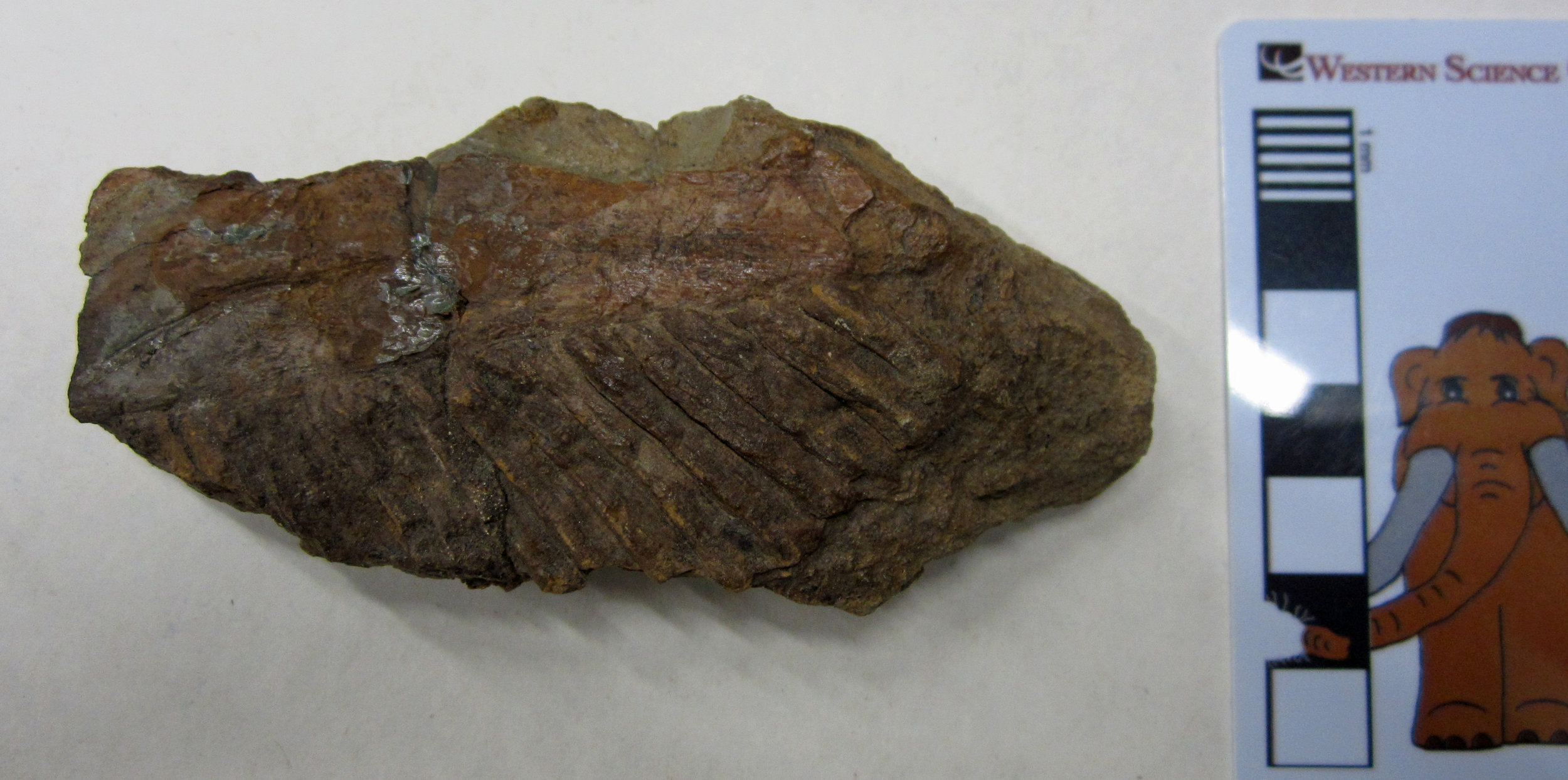 The fossilized bones of dinosaurs and other prehistoric animals certainly hog the spotlight, and they are spectacular. But alongside the bones of giants such as Tyrannosaurus is a very different, much more abundant type of fossil: ancient plants. Paleobotany, the study of fossil plants, is a vital part of understanding Earth history. Fossil plants provide data on bygone environments, ecology, and climate.This fossil is the impression of a 67-million-year-old palm leaf. It was found in the Hell Creek Formation of Montana by local fossil hunter Harley Garbani and donated to the Western Science Center by his wife, Mary. The living plant probably looked much like modern palm trees, and points to a much warmer climate in Montana during the Late Cretaceous Epoch than today. Next time you see a living palm tree swaying in the breeze, imagine a T. rex under it seeking shade from the midday sun. Post by Curator Dr. Andrew McDonald
The fossilized bones of dinosaurs and other prehistoric animals certainly hog the spotlight, and they are spectacular. But alongside the bones of giants such as Tyrannosaurus is a very different, much more abundant type of fossil: ancient plants. Paleobotany, the study of fossil plants, is a vital part of understanding Earth history. Fossil plants provide data on bygone environments, ecology, and climate.This fossil is the impression of a 67-million-year-old palm leaf. It was found in the Hell Creek Formation of Montana by local fossil hunter Harley Garbani and donated to the Western Science Center by his wife, Mary. The living plant probably looked much like modern palm trees, and points to a much warmer climate in Montana during the Late Cretaceous Epoch than today. Next time you see a living palm tree swaying in the breeze, imagine a T. rex under it seeking shade from the midday sun. Post by Curator Dr. Andrew McDonald
Fossil Friday - Horse molar
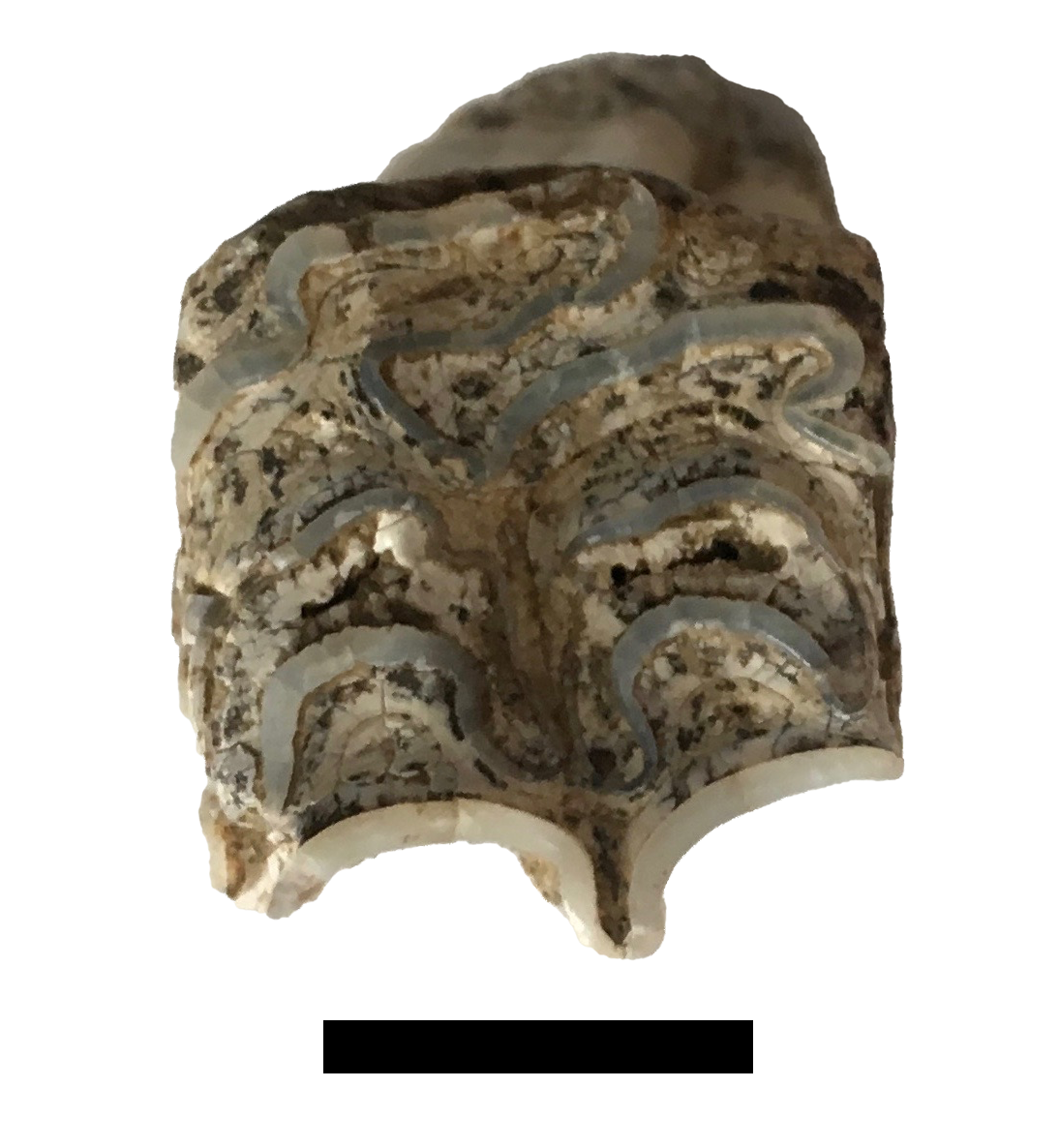 One thing has become quickly obvious as we've been examining the Harveston fossil collection: there are a lot of horses.This is one of several isolated horse teeth from Harveston. This specimen is an upper right 1st molar, and is of particular interest because it is quite a bit smaller than most of our Harveston horses, as can be seen below:
One thing has become quickly obvious as we've been examining the Harveston fossil collection: there are a lot of horses.This is one of several isolated horse teeth from Harveston. This specimen is an upper right 1st molar, and is of particular interest because it is quite a bit smaller than most of our Harveston horses, as can be seen below: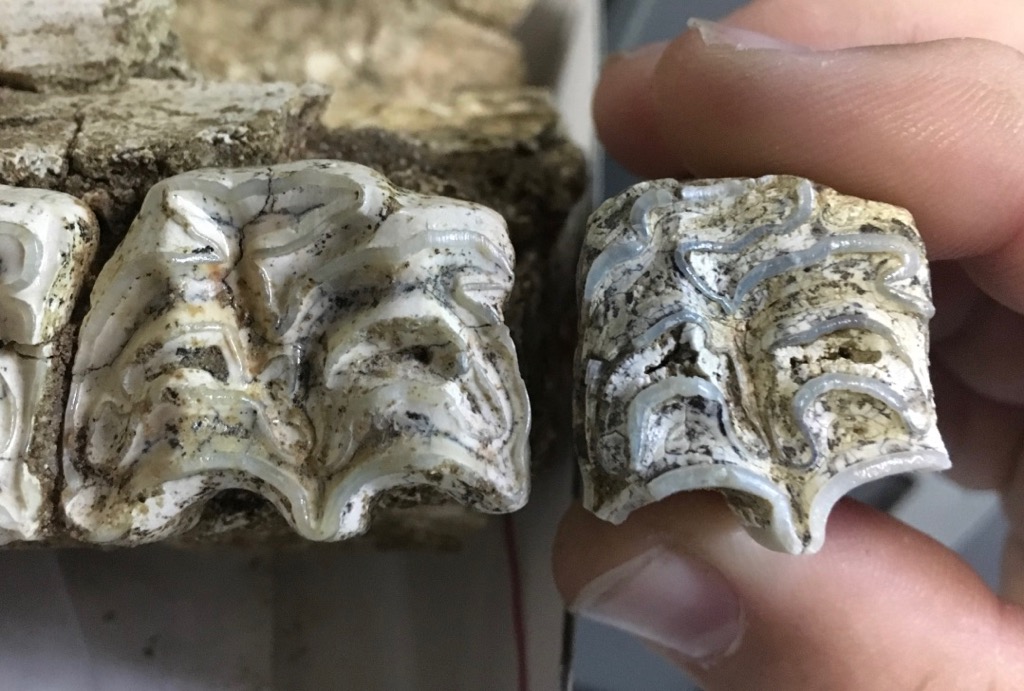 It turns out there were actually two species of horses at Harveston. The larger and much more common one is Equus occidentalis, while the smaller, rare species is generally called Equus conversidens (there are some nomenclatural issues with this name and with Equus species in general, but I'm not going to get into that here). E. conversidens makes up perhaps 5% of the Harveston horses. This seems to be a general trend for southern California sites, including Diamond Valley Lake, with both species generally present, and E. occidentalis being much more common.We've made a 3D scan of this E. conversidens tooth (WSC 24676) available for download on Sketchfab at https://skfb.ly/6yJNq.
It turns out there were actually two species of horses at Harveston. The larger and much more common one is Equus occidentalis, while the smaller, rare species is generally called Equus conversidens (there are some nomenclatural issues with this name and with Equus species in general, but I'm not going to get into that here). E. conversidens makes up perhaps 5% of the Harveston horses. This seems to be a general trend for southern California sites, including Diamond Valley Lake, with both species generally present, and E. occidentalis being much more common.We've made a 3D scan of this E. conversidens tooth (WSC 24676) available for download on Sketchfab at https://skfb.ly/6yJNq.

